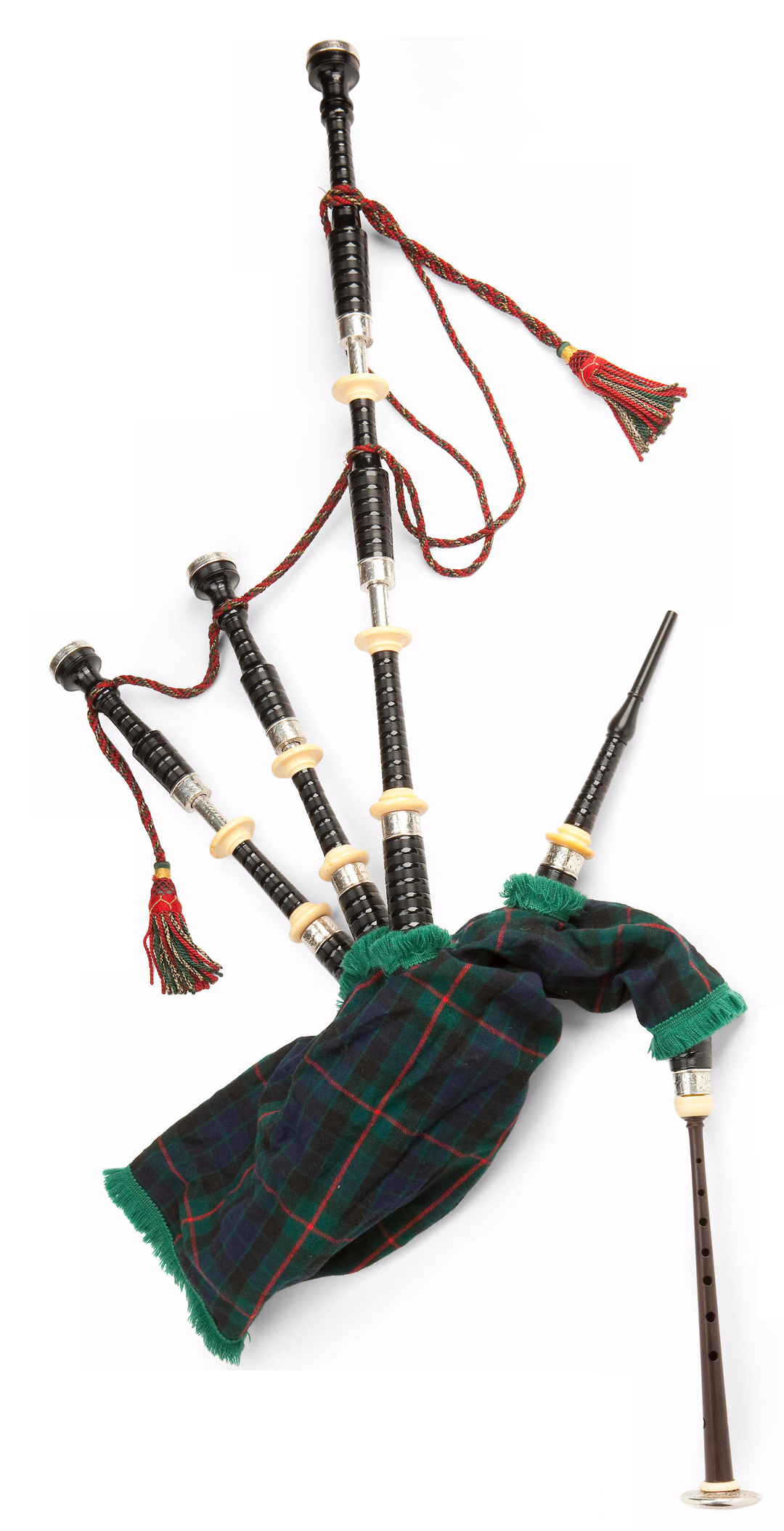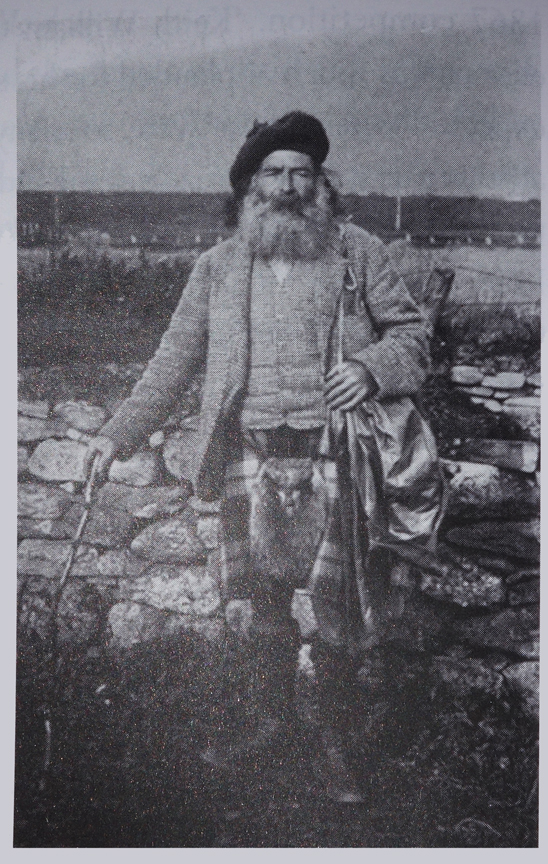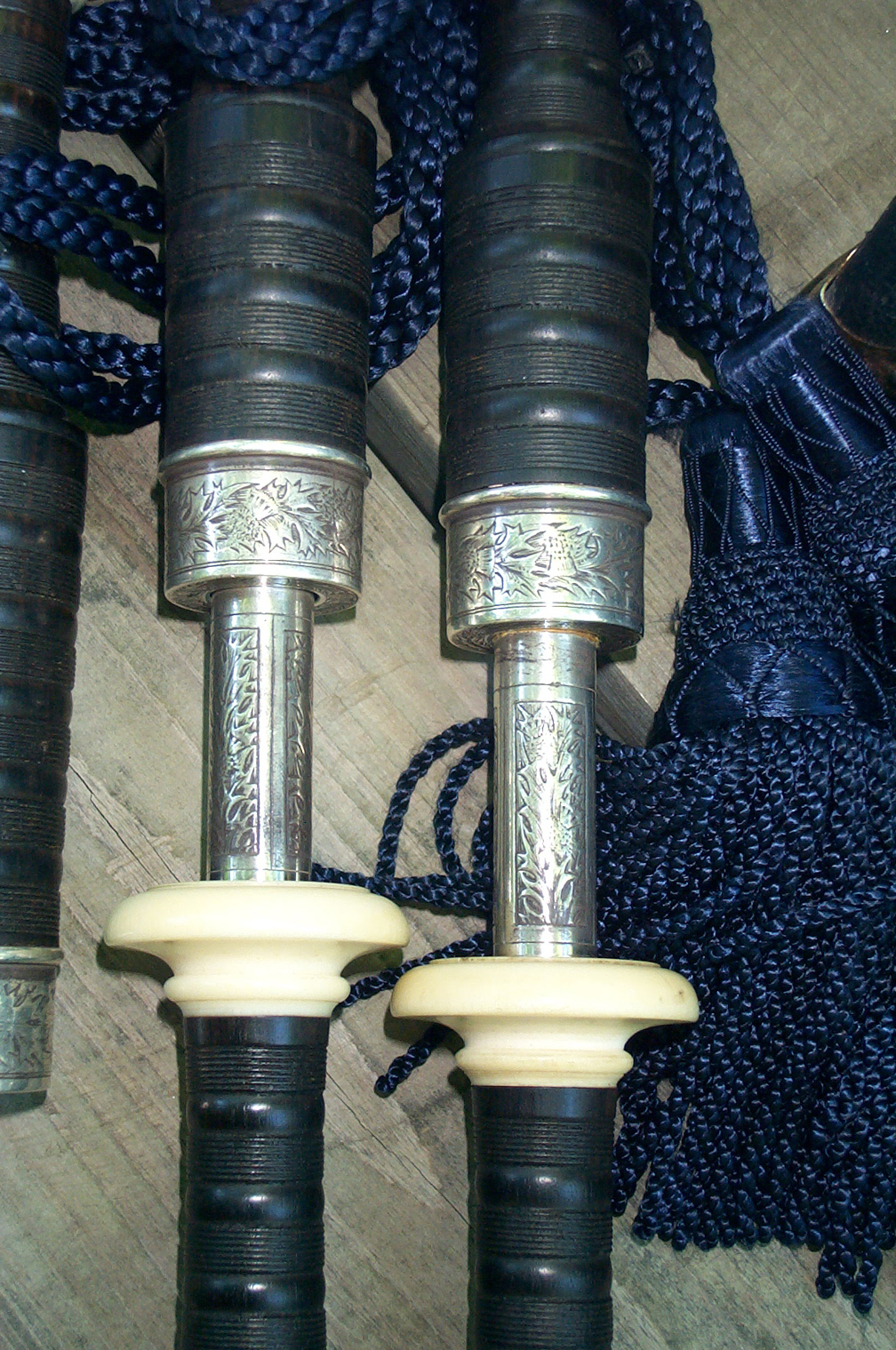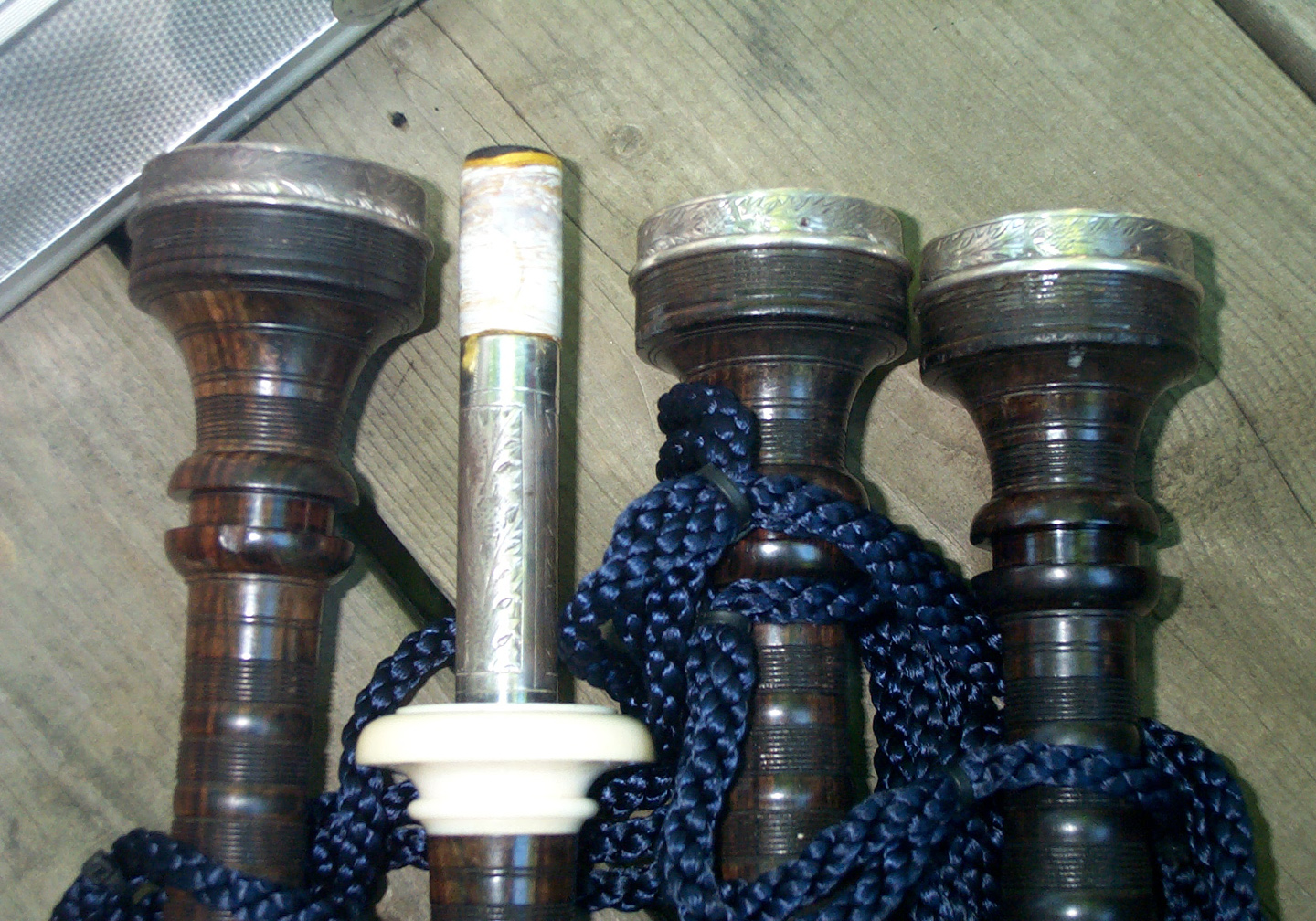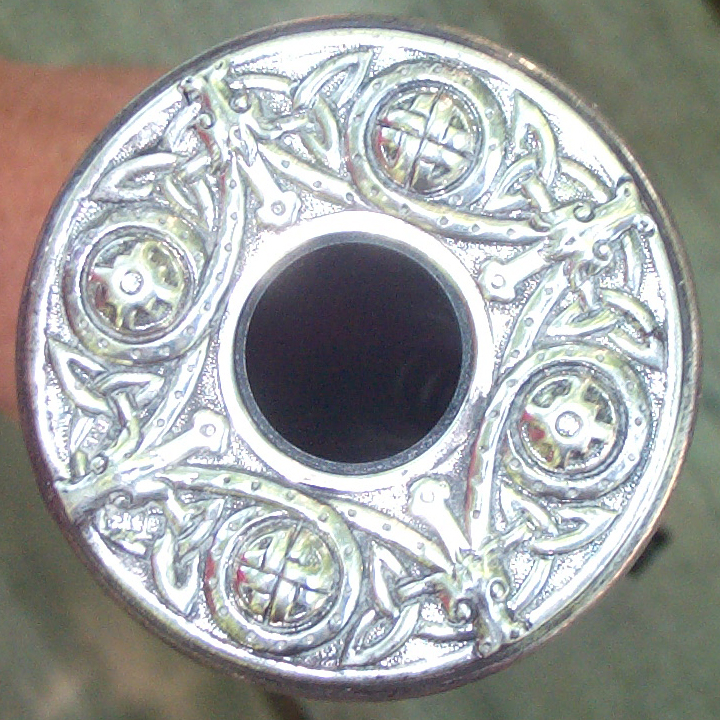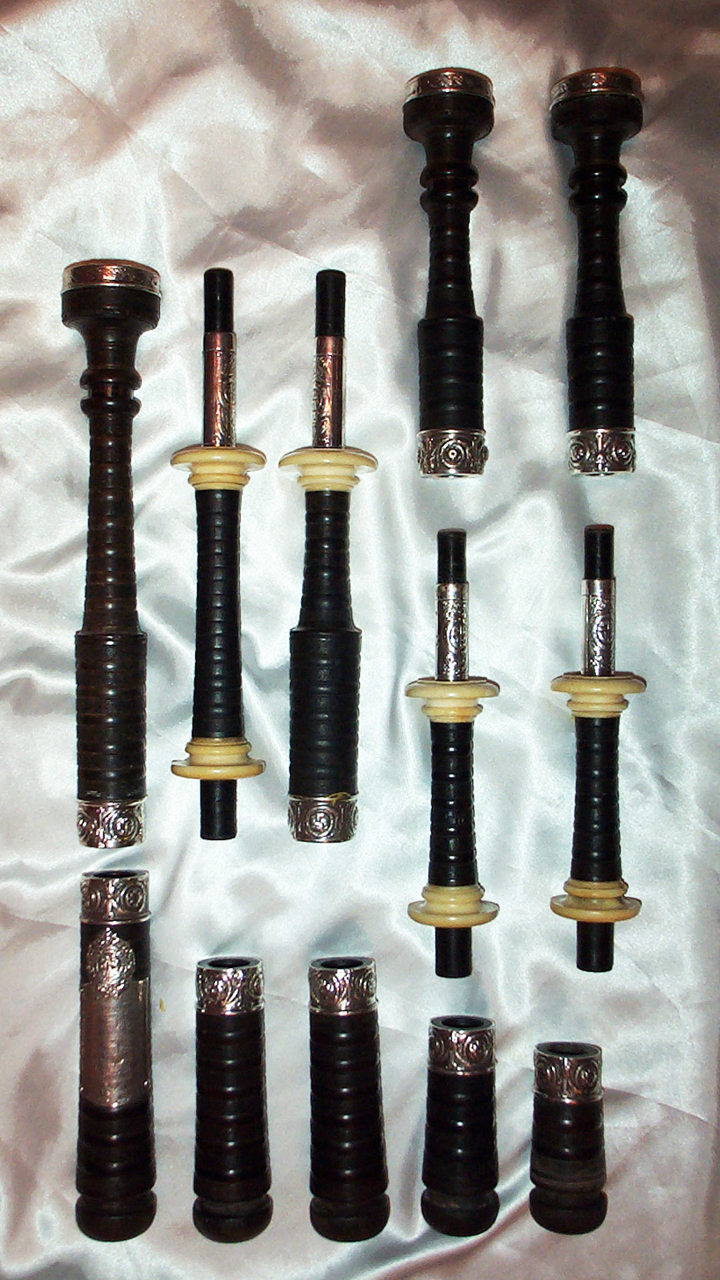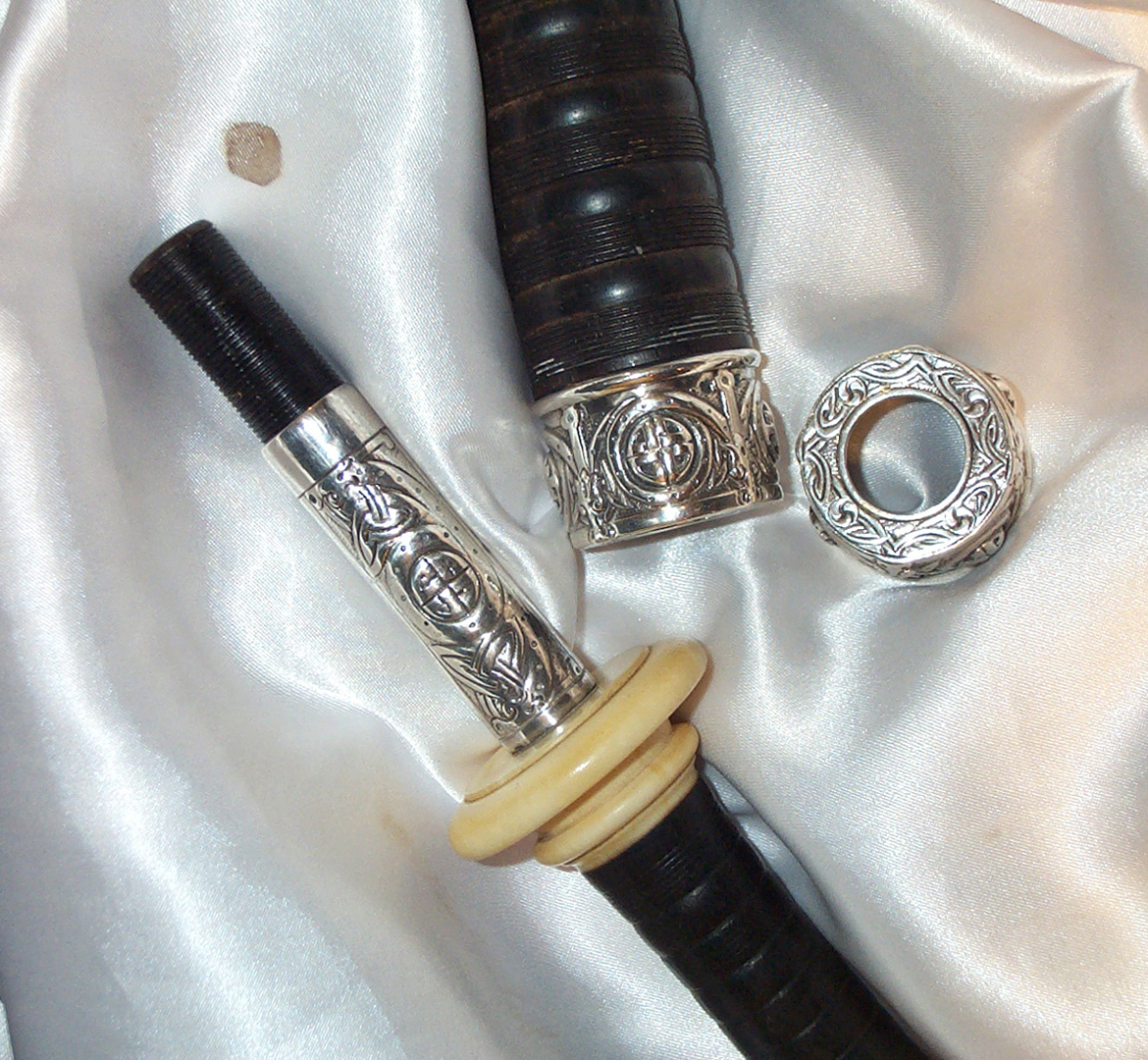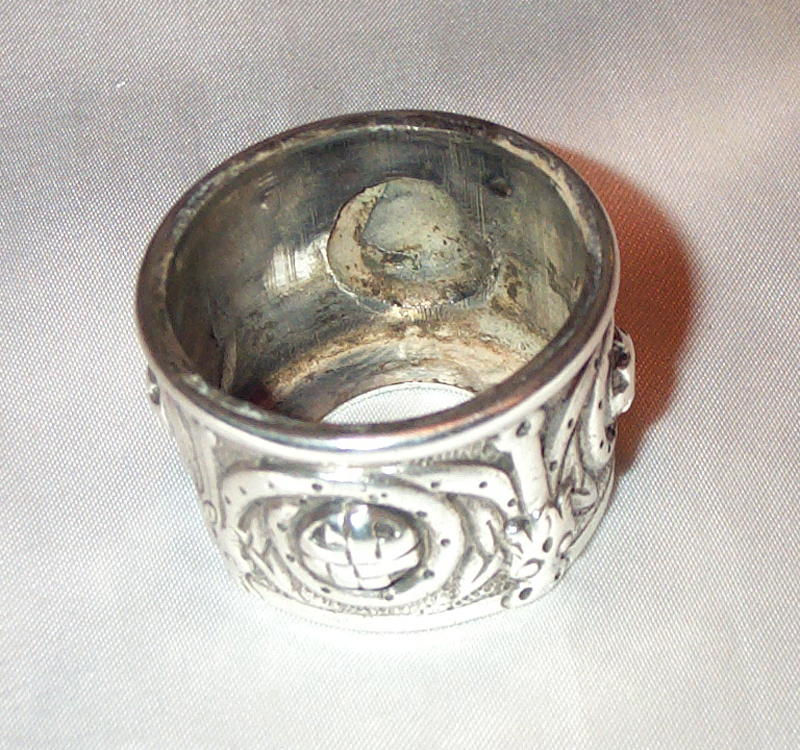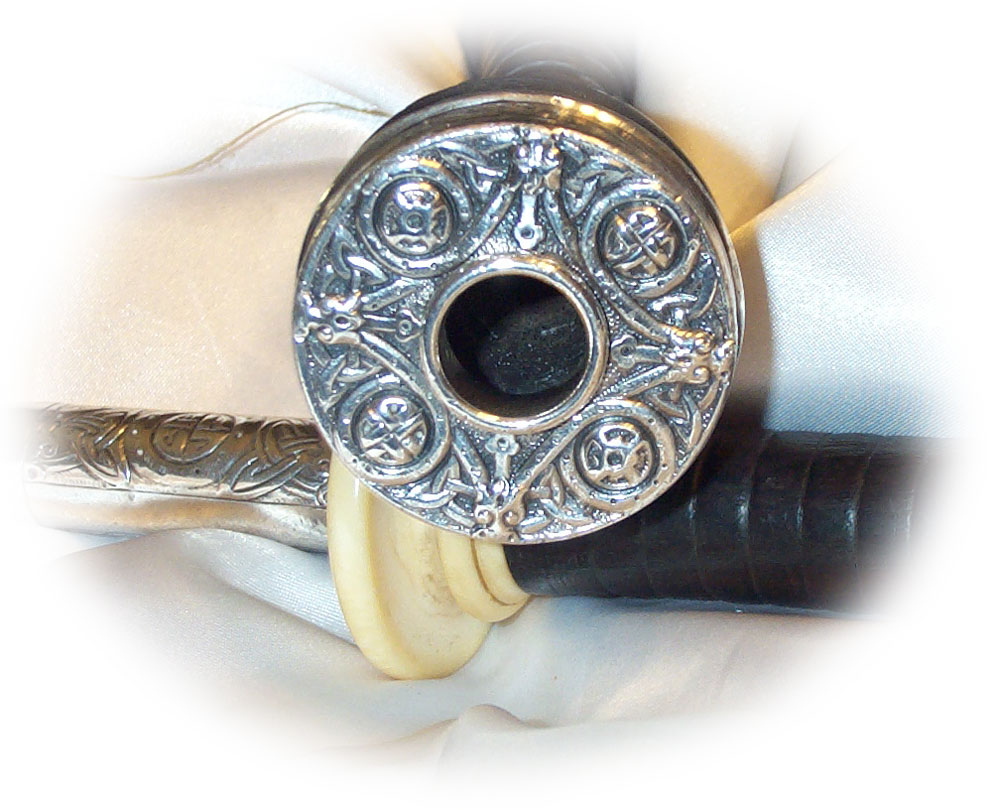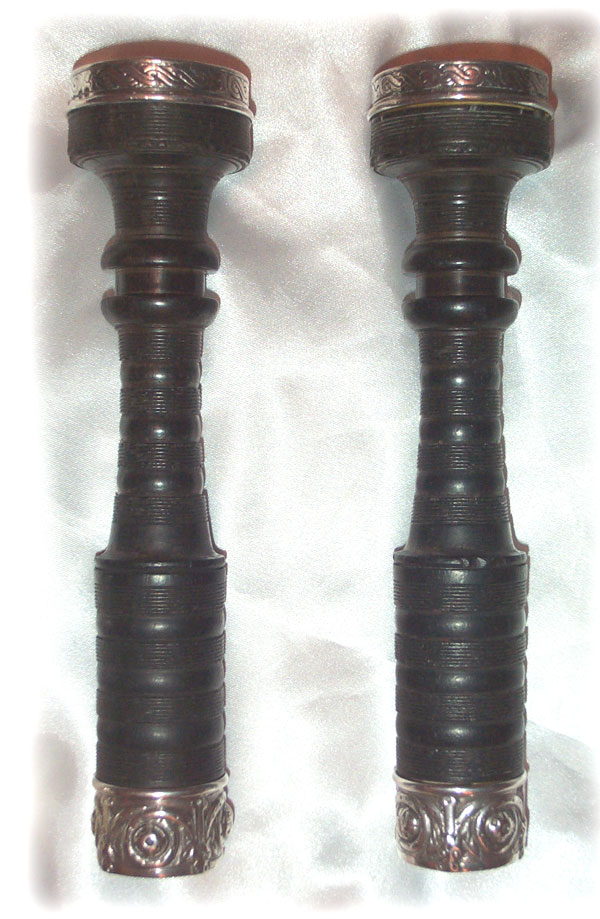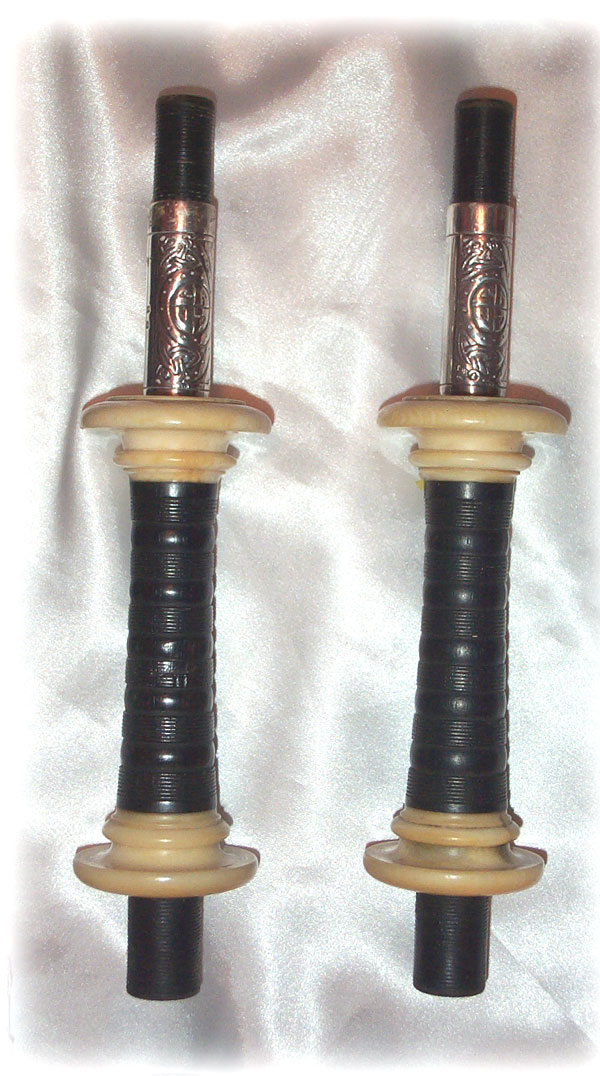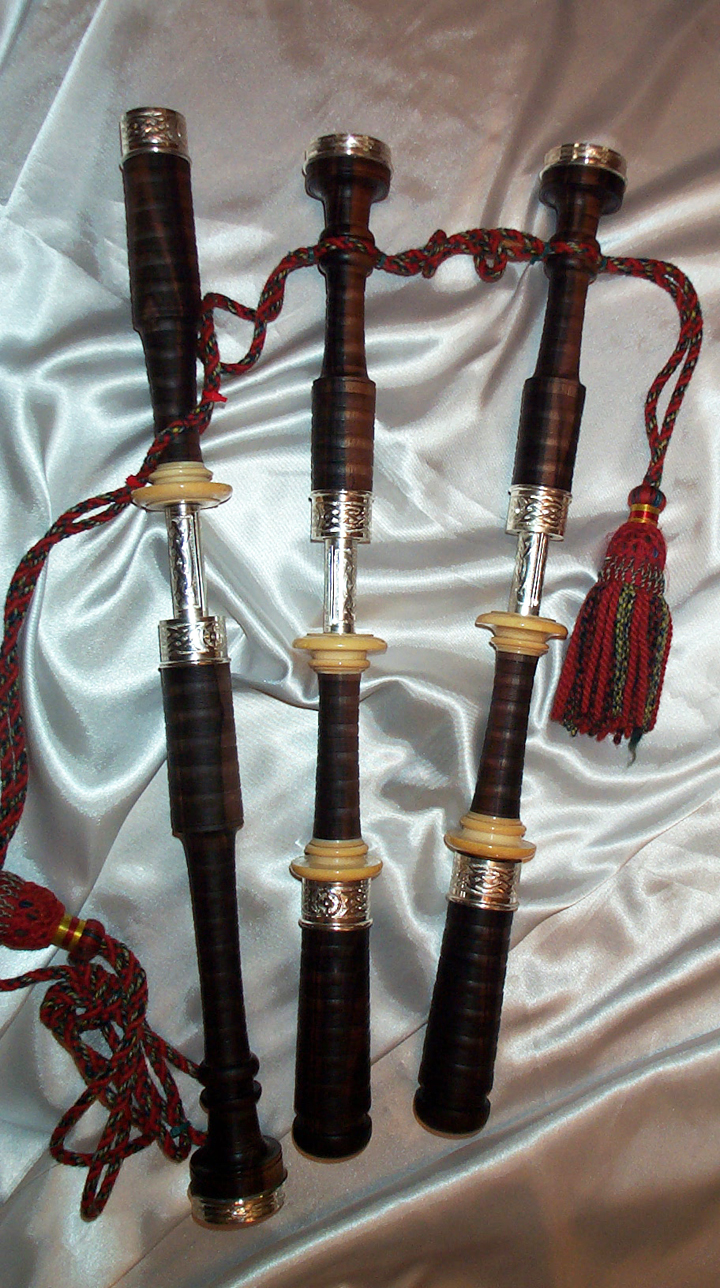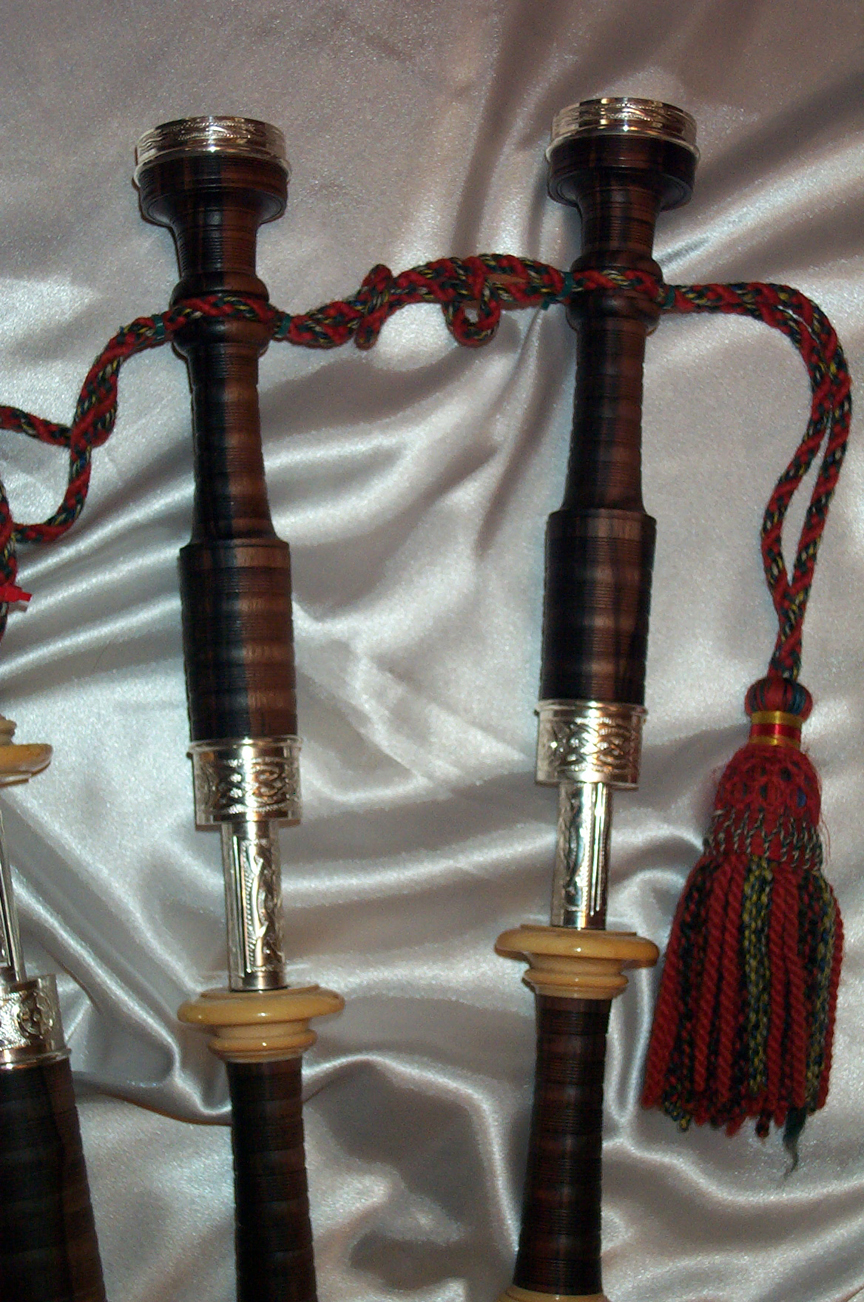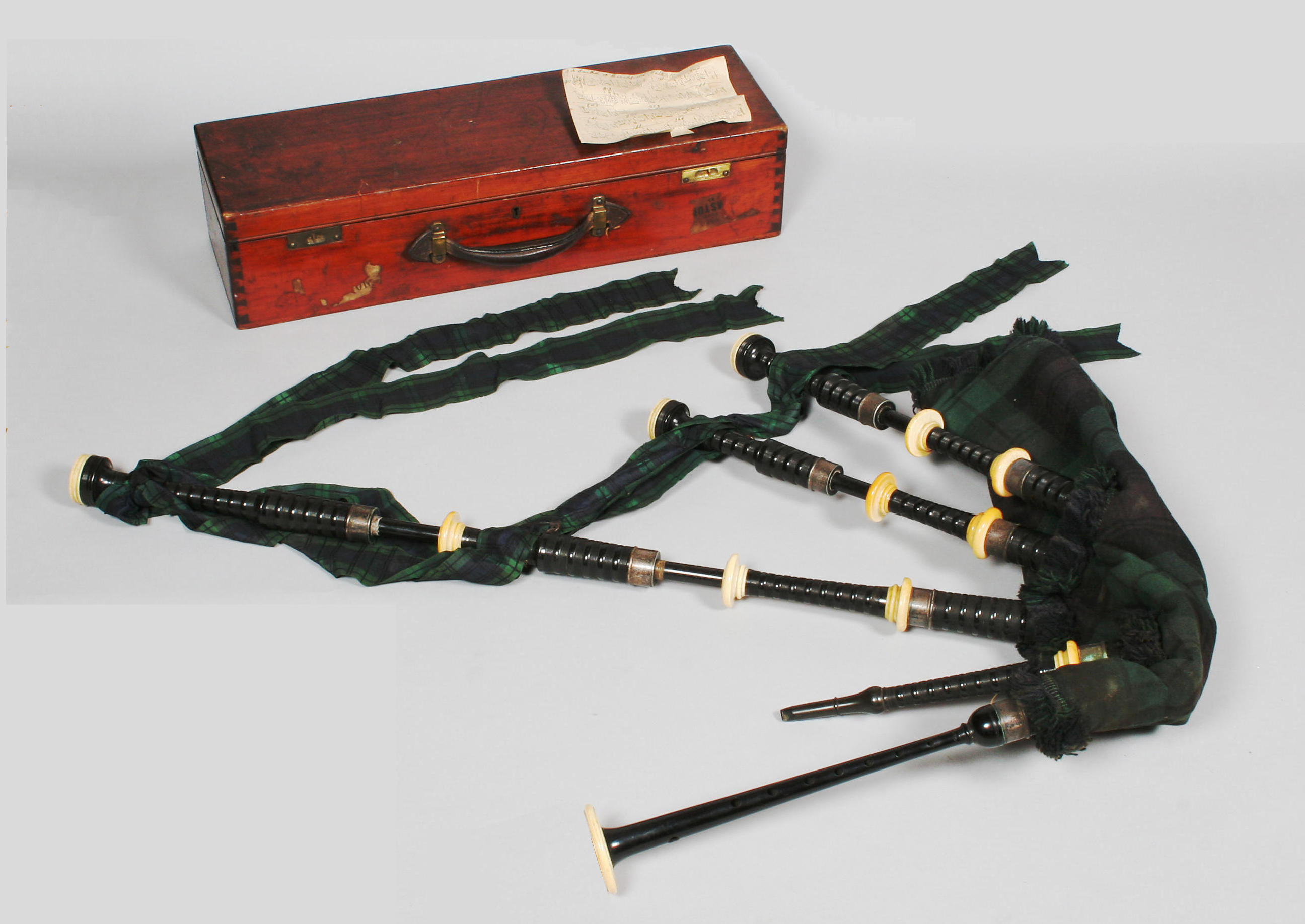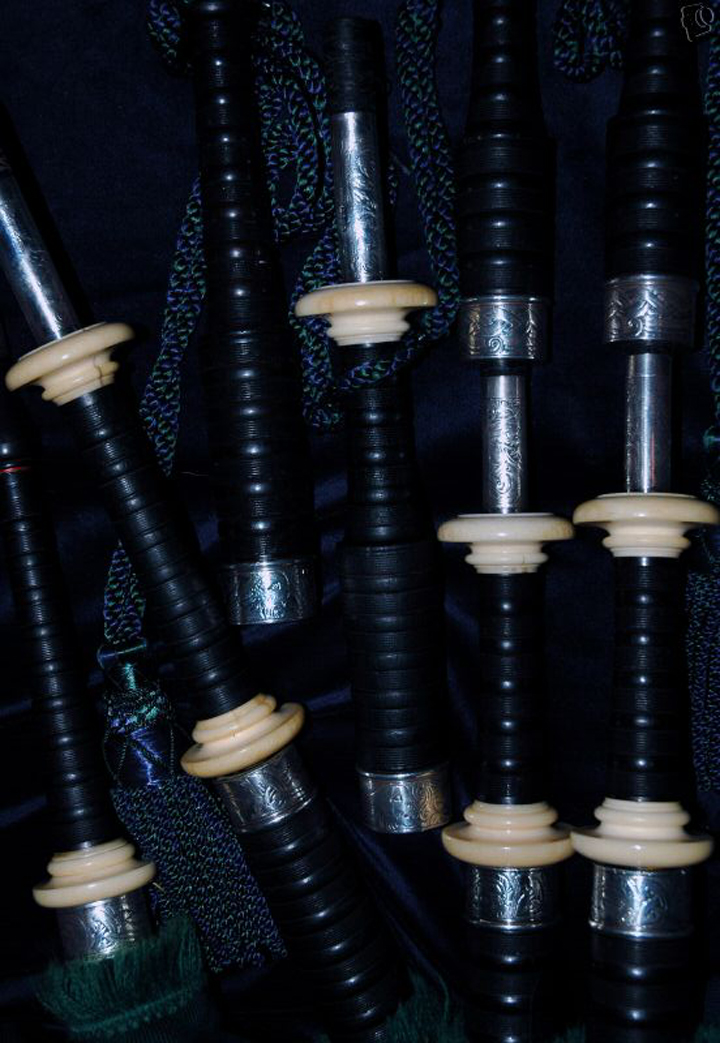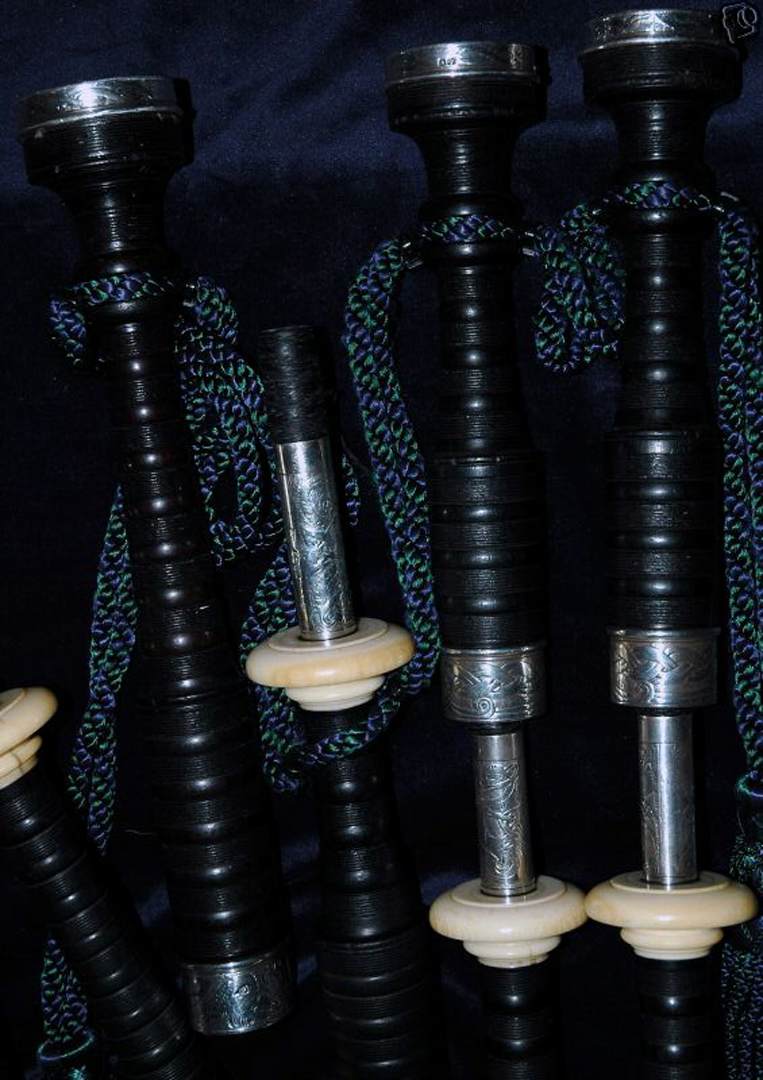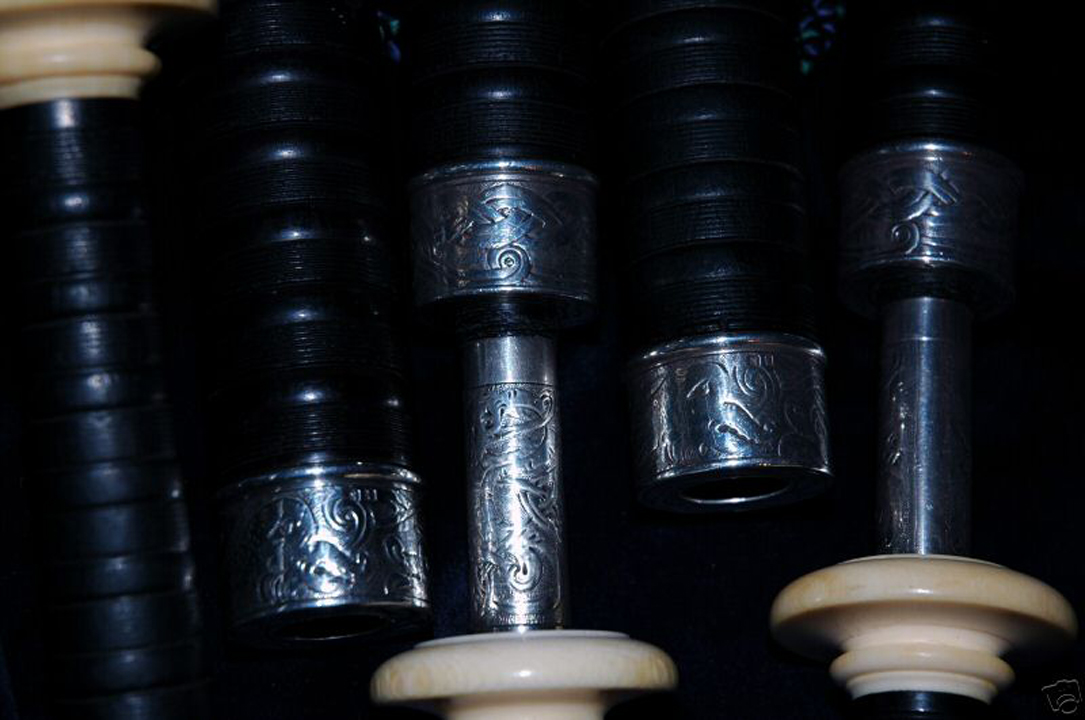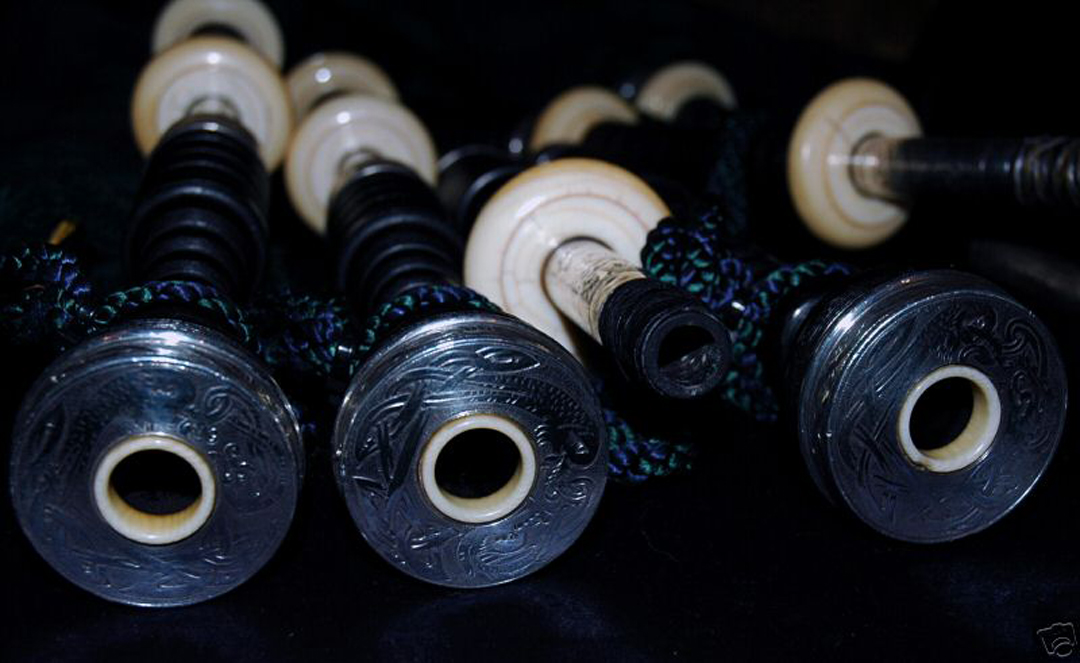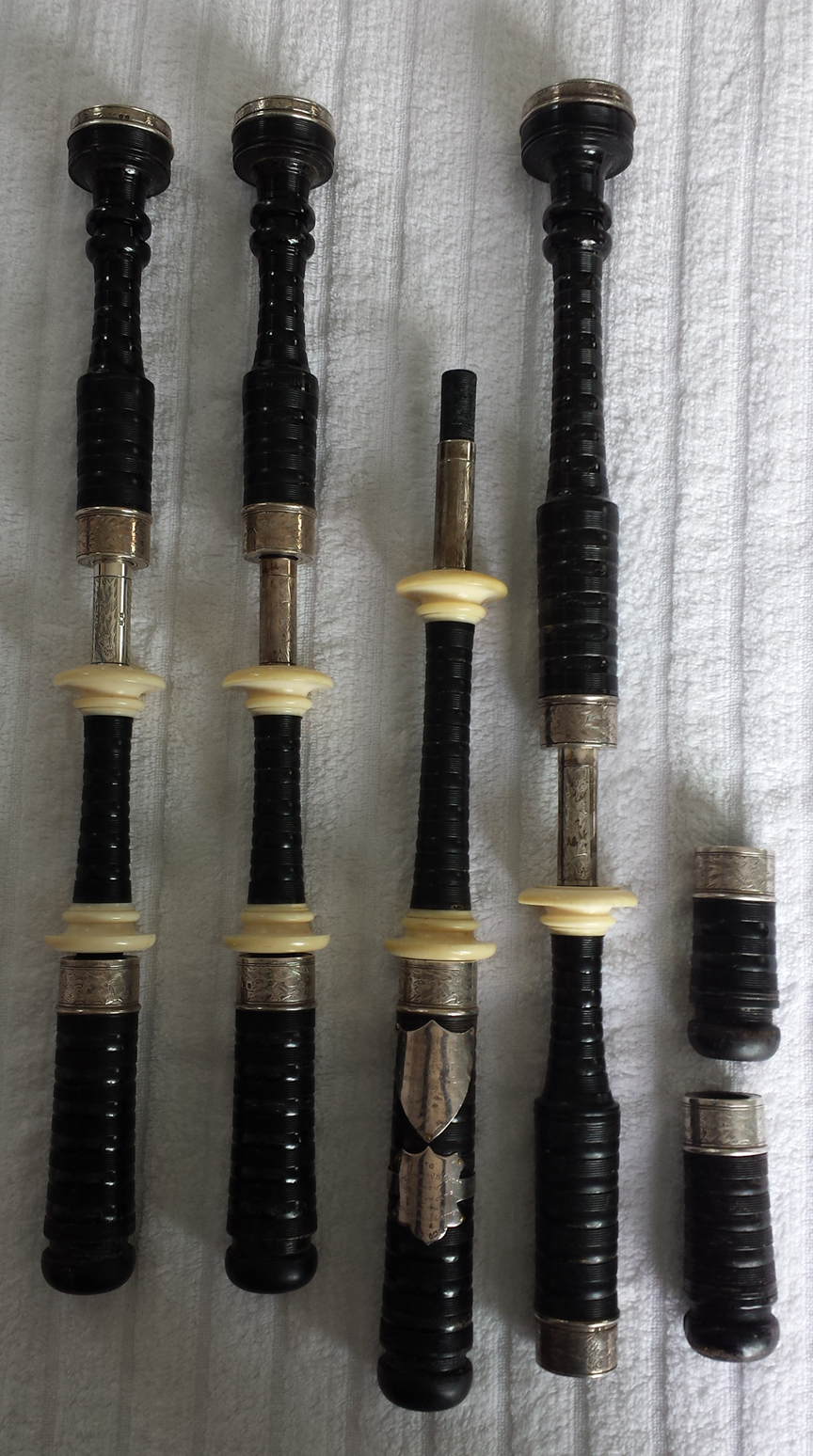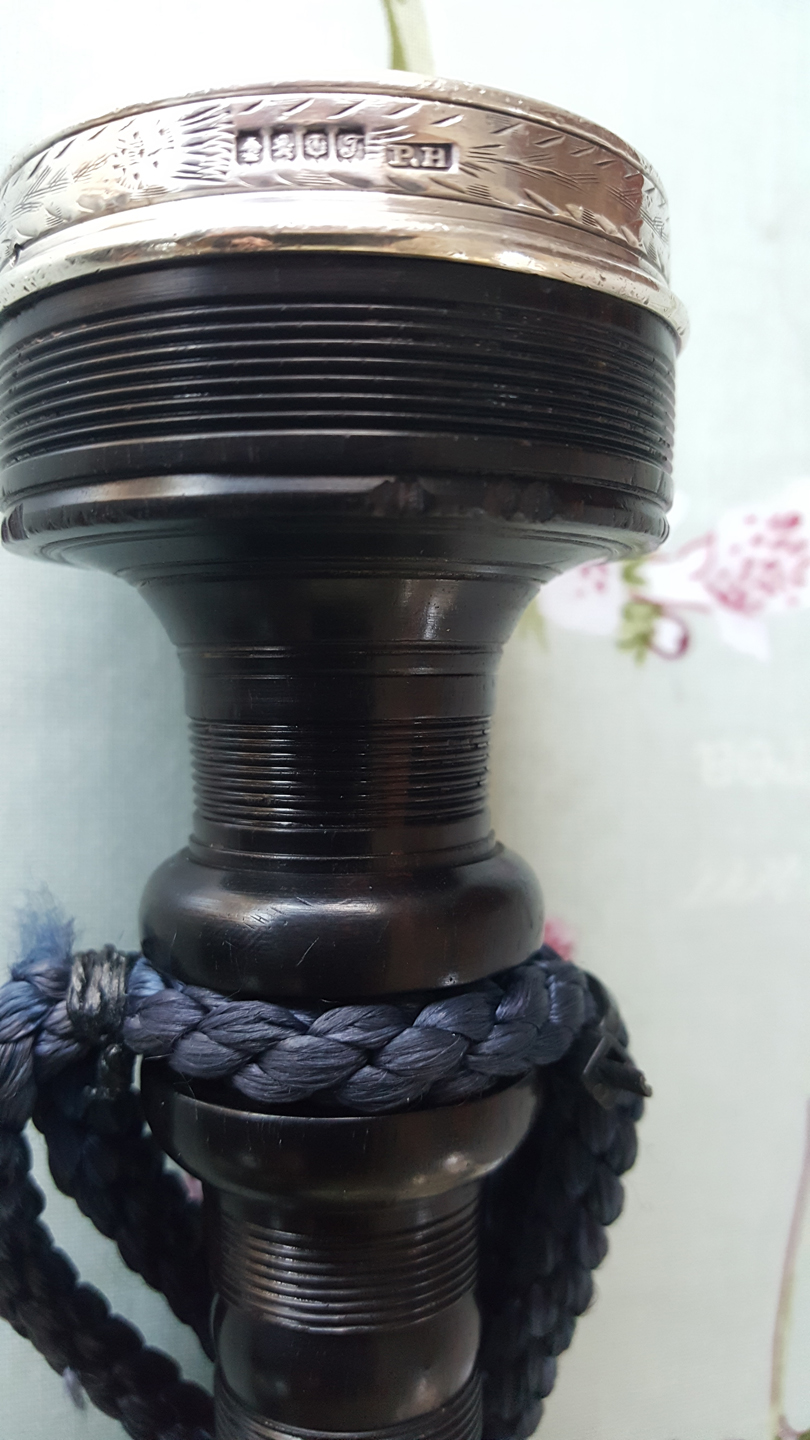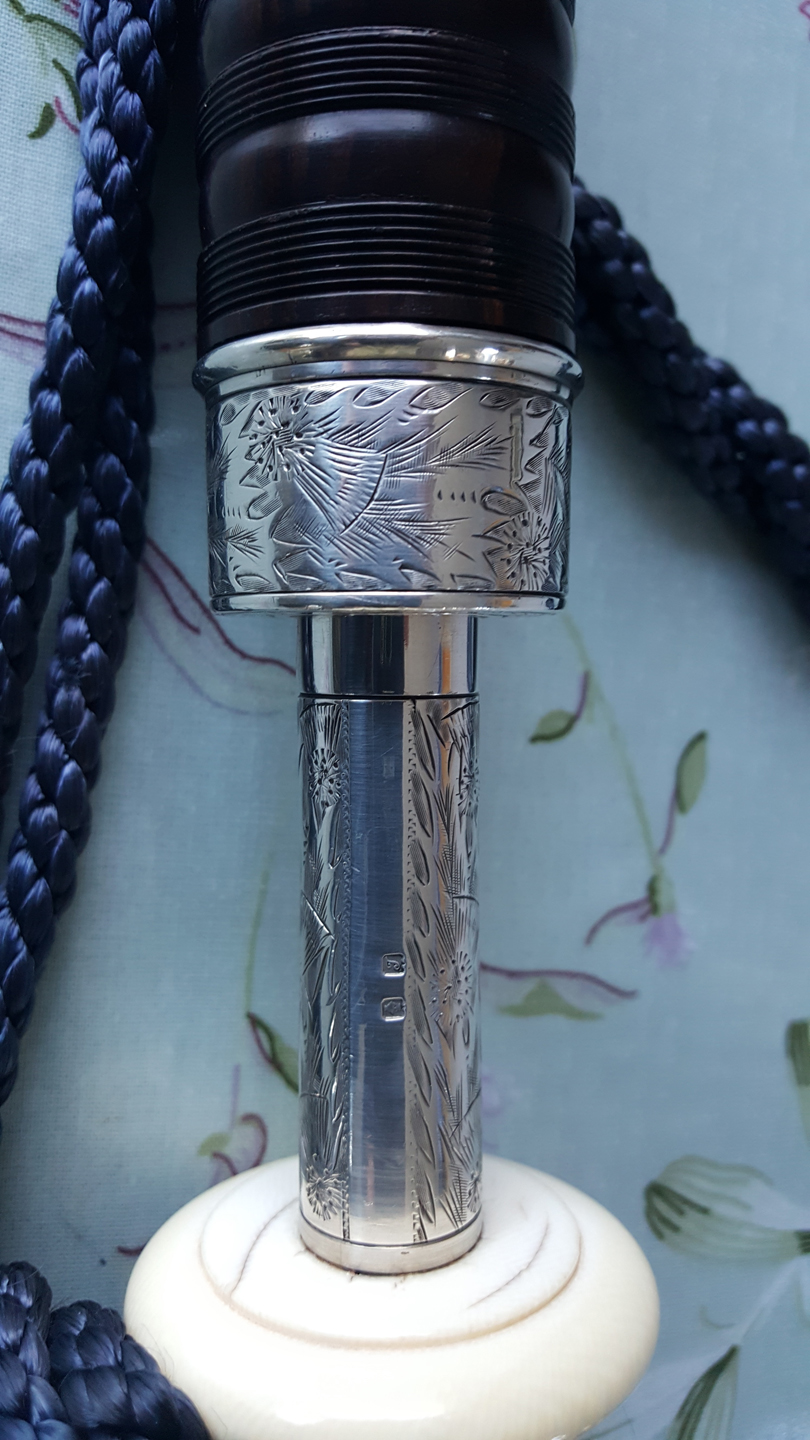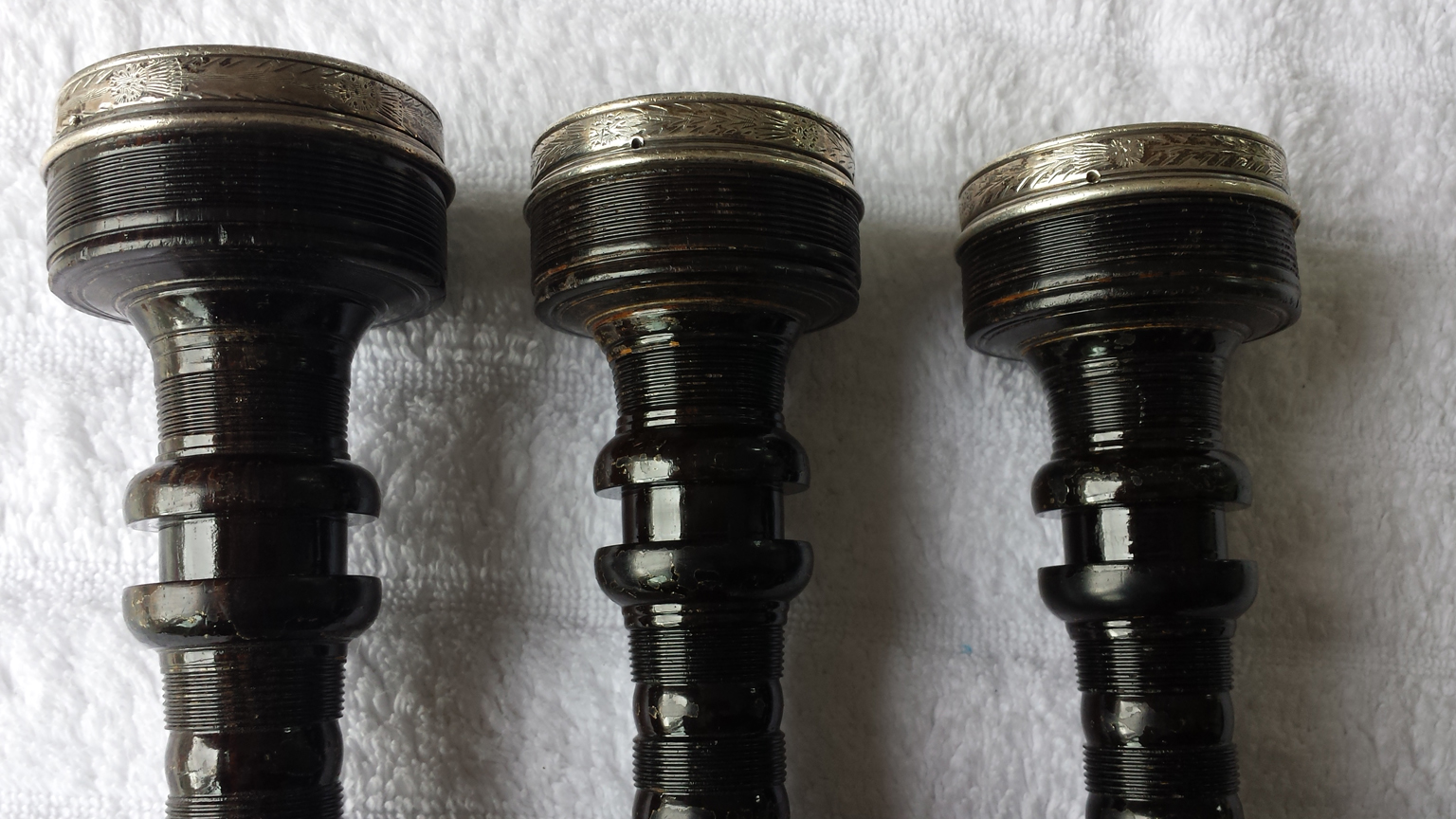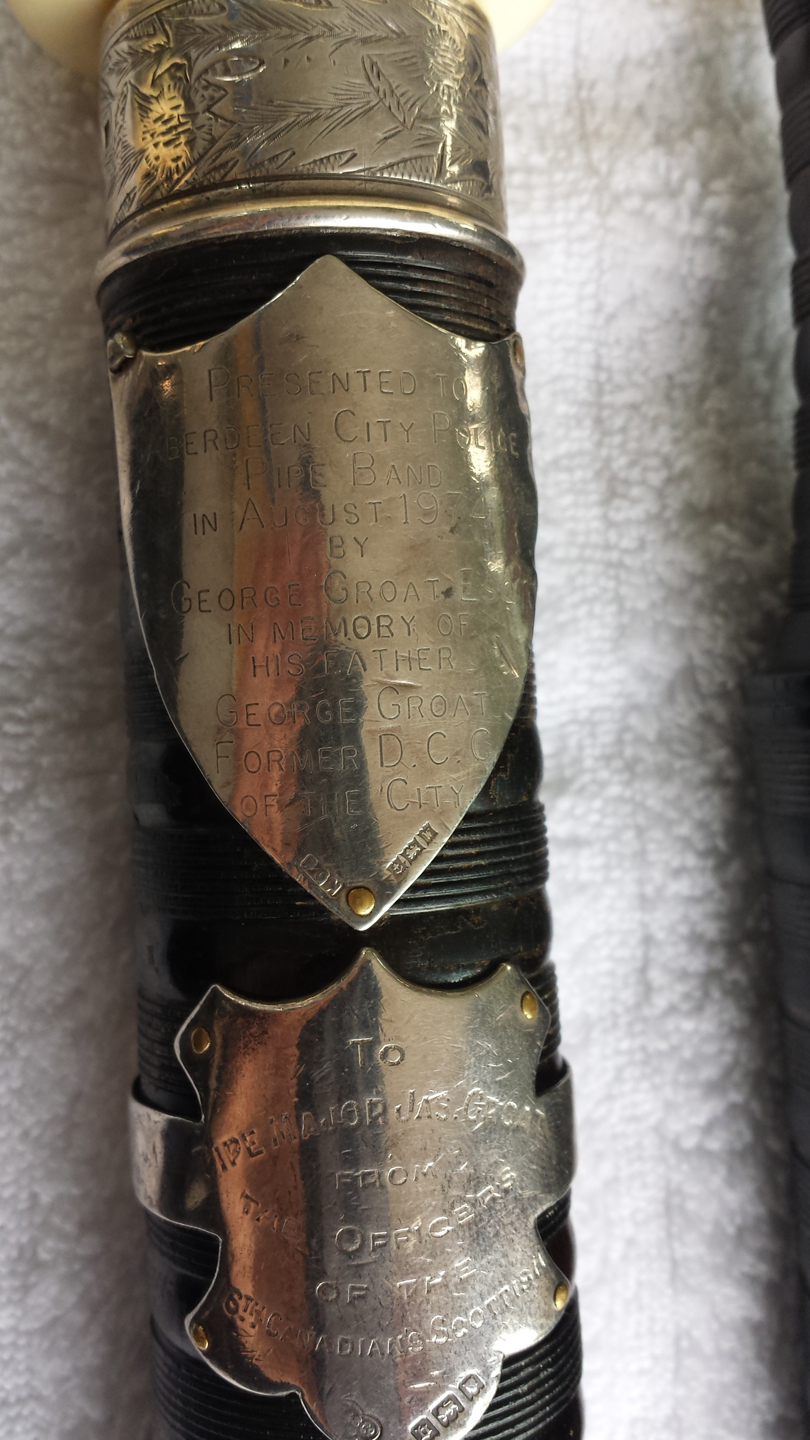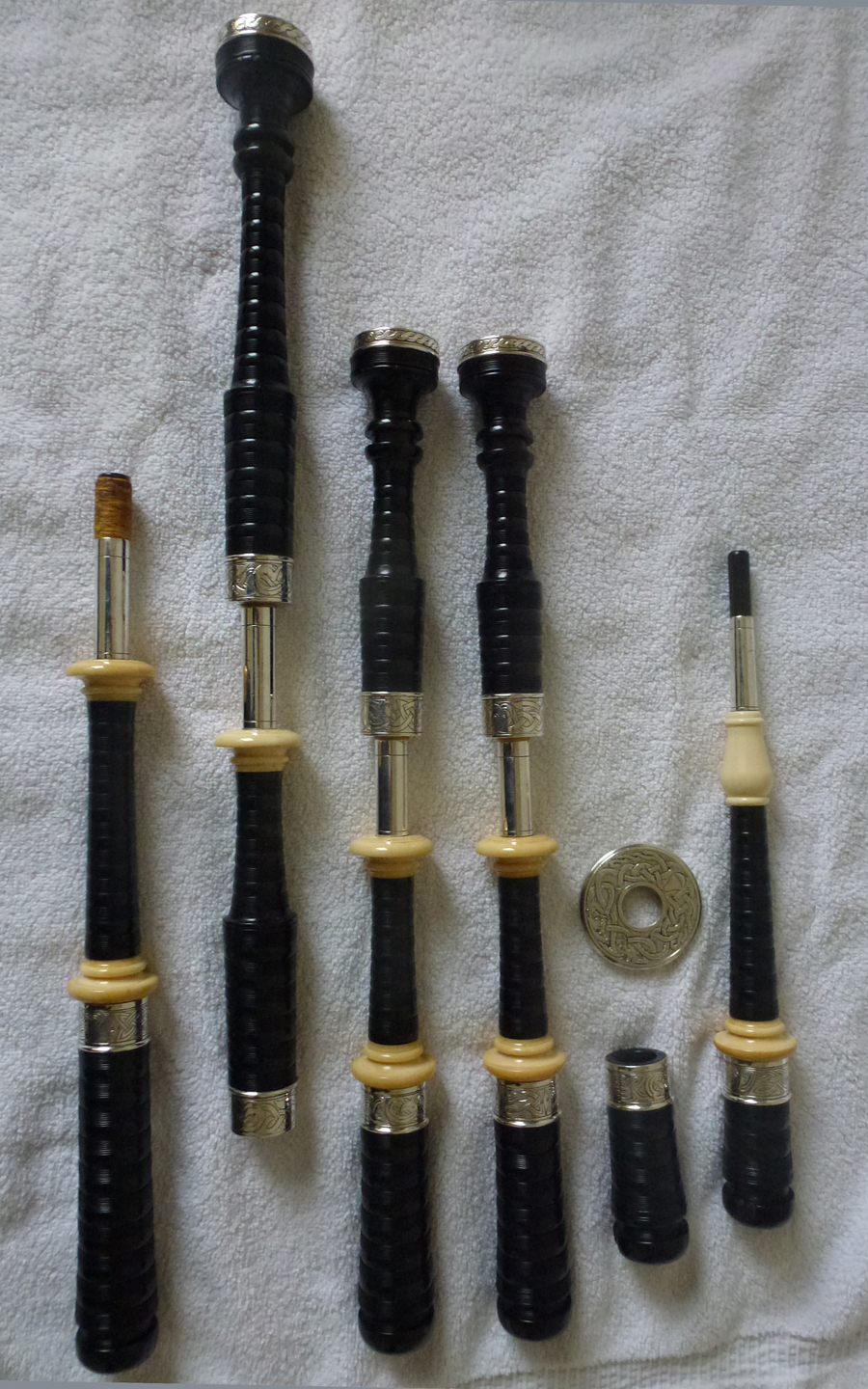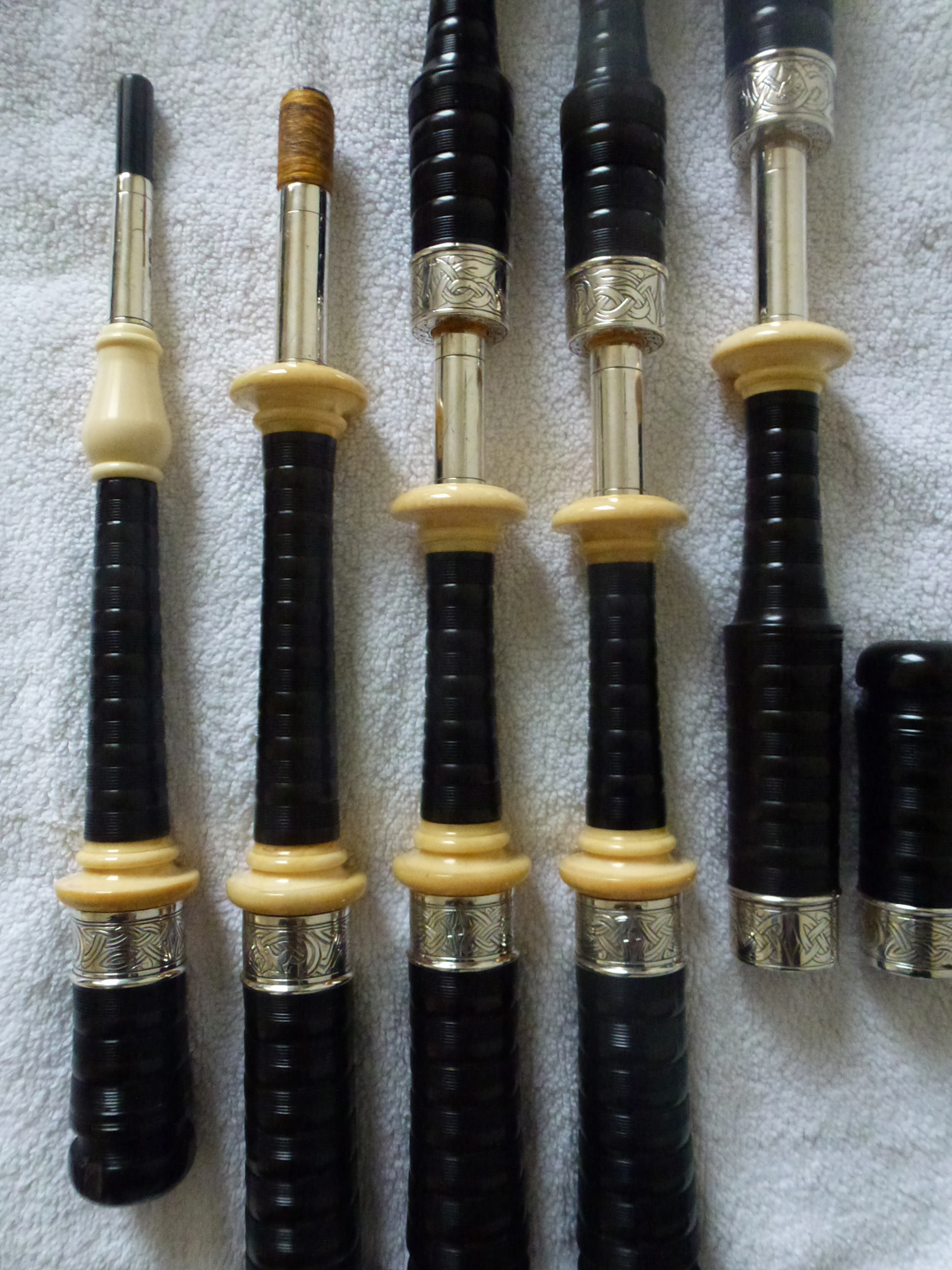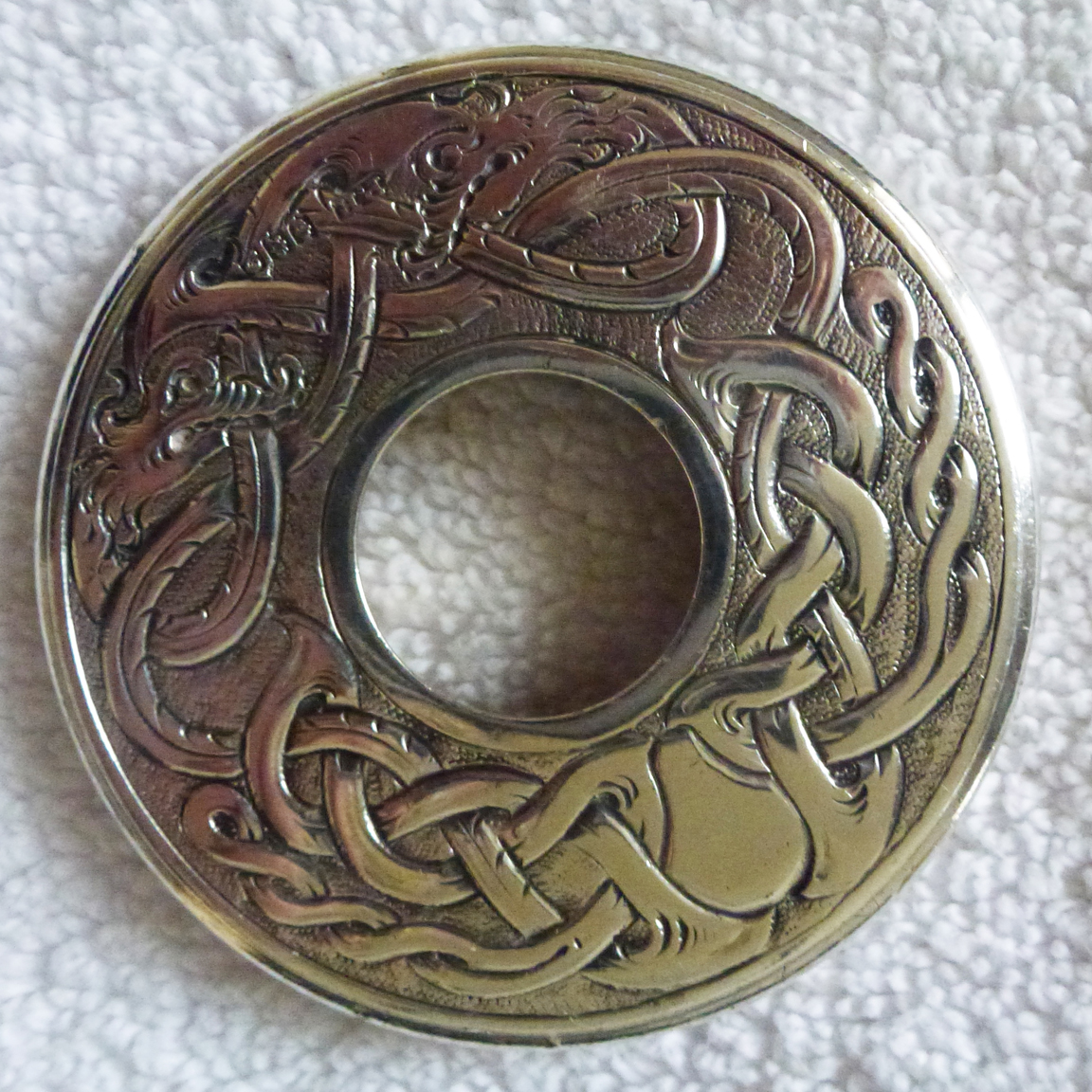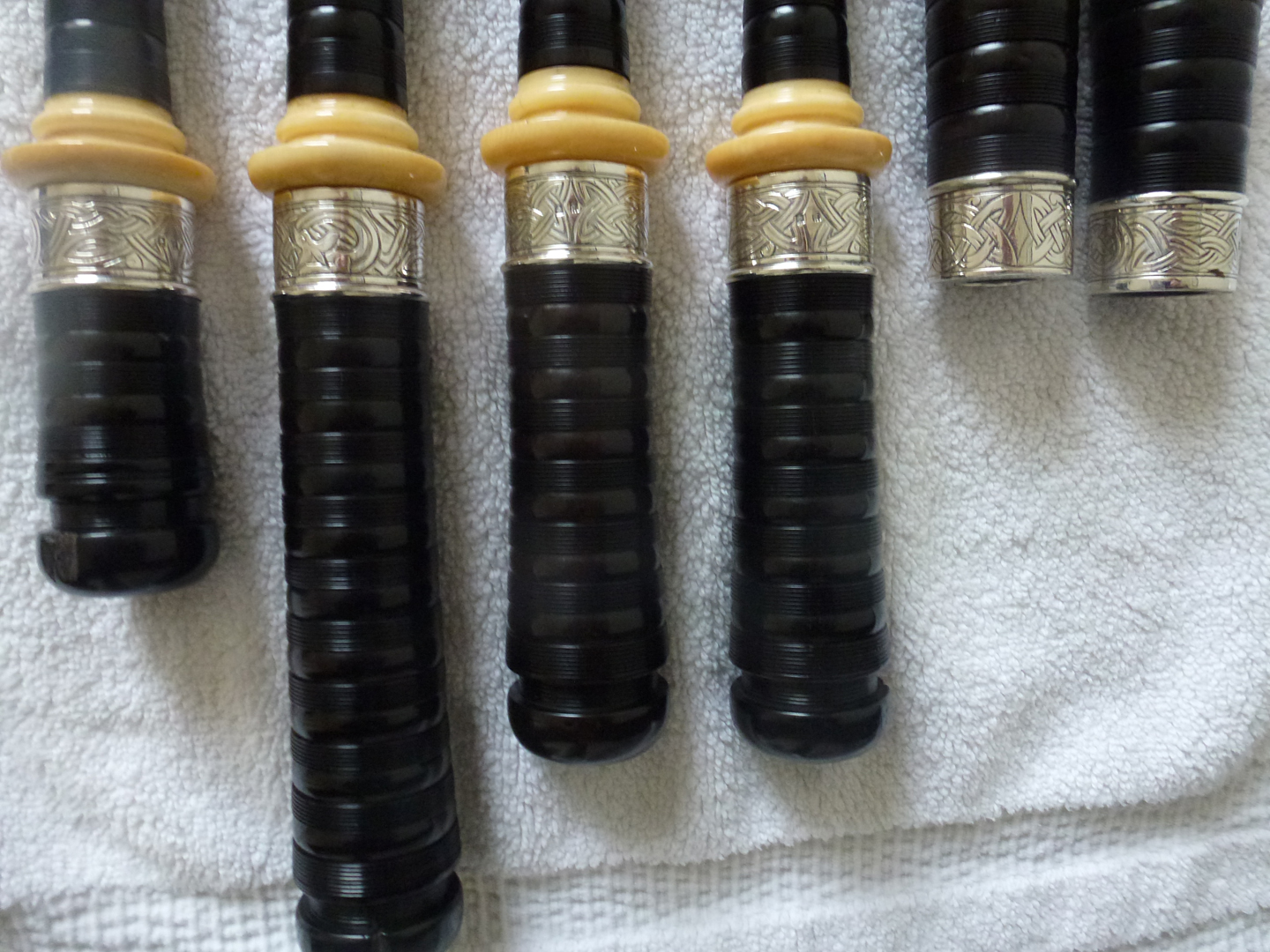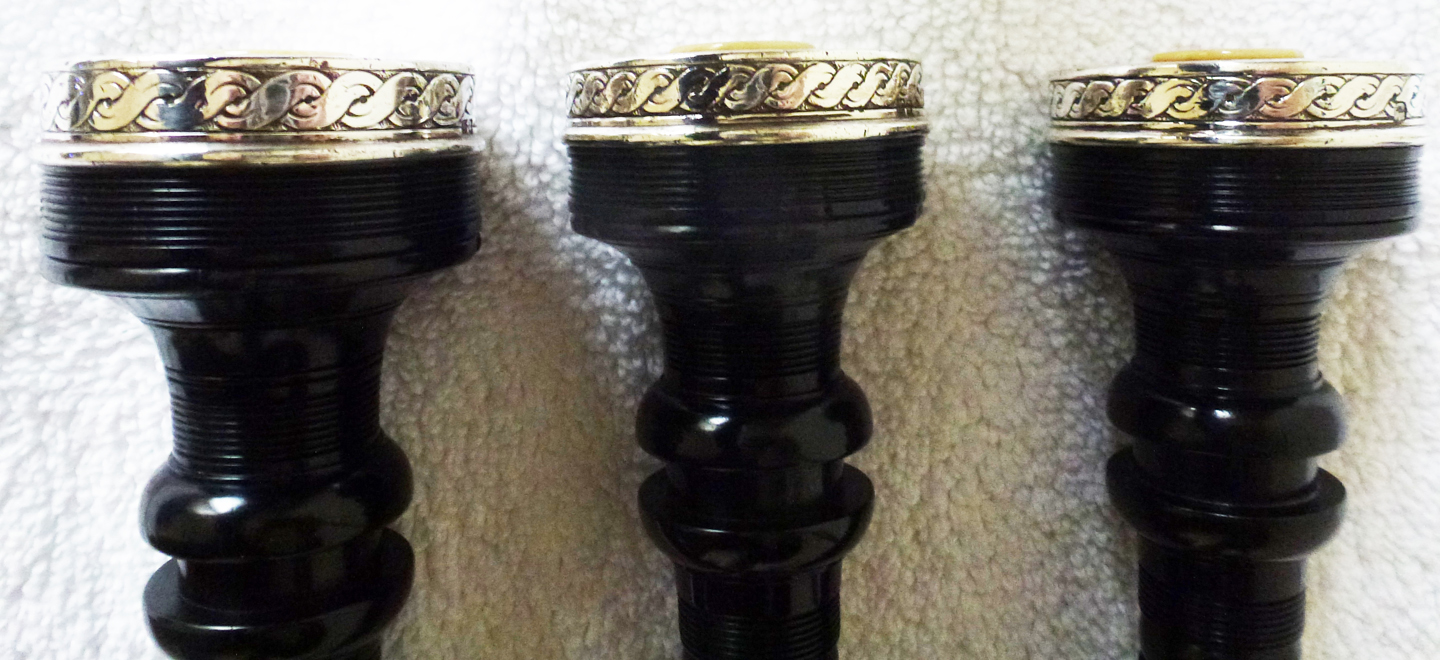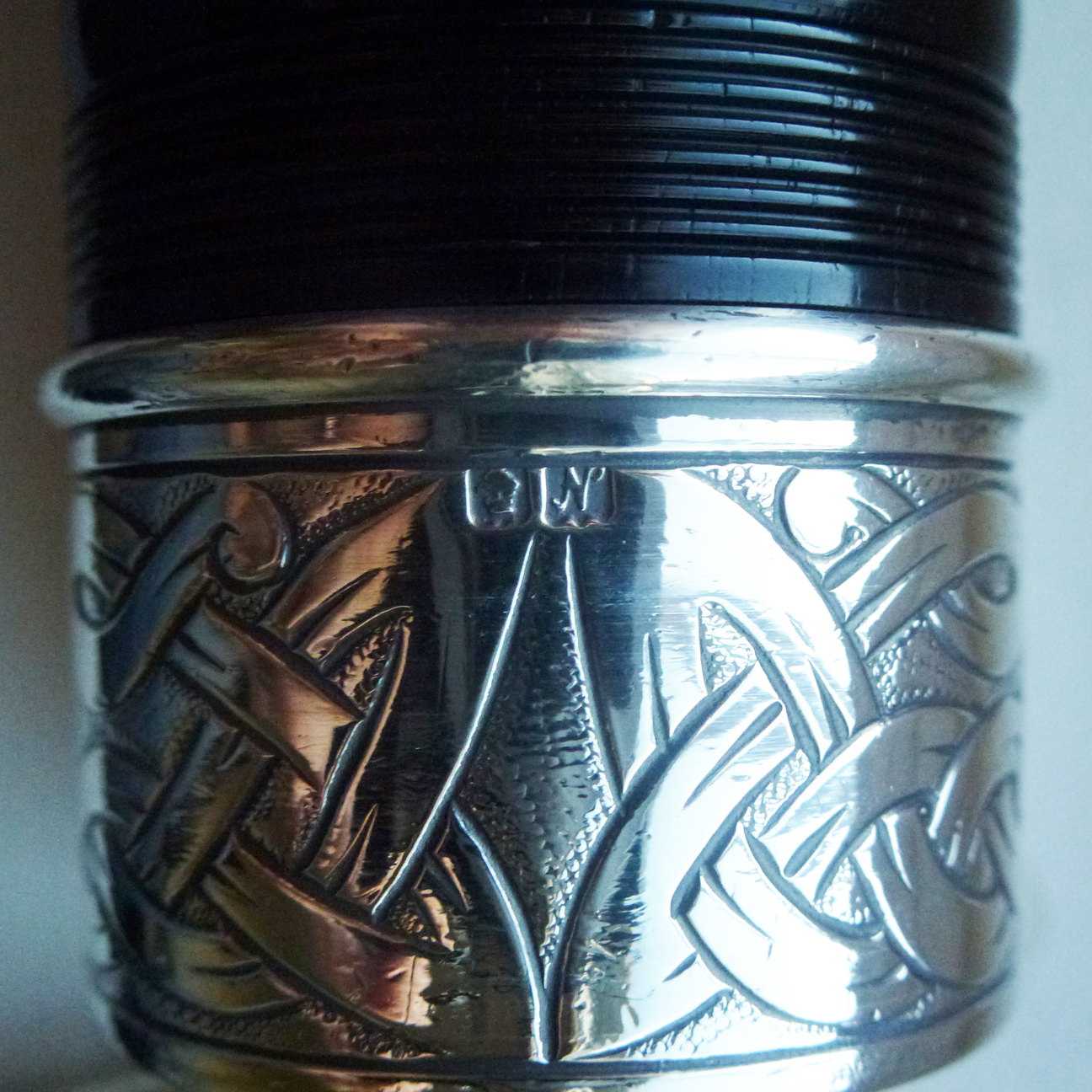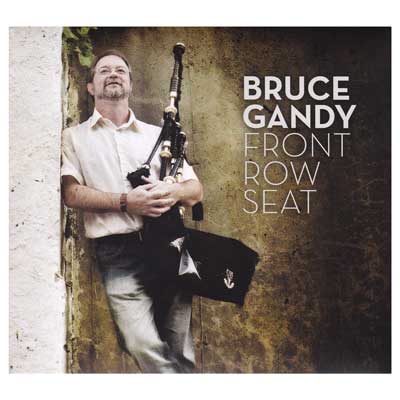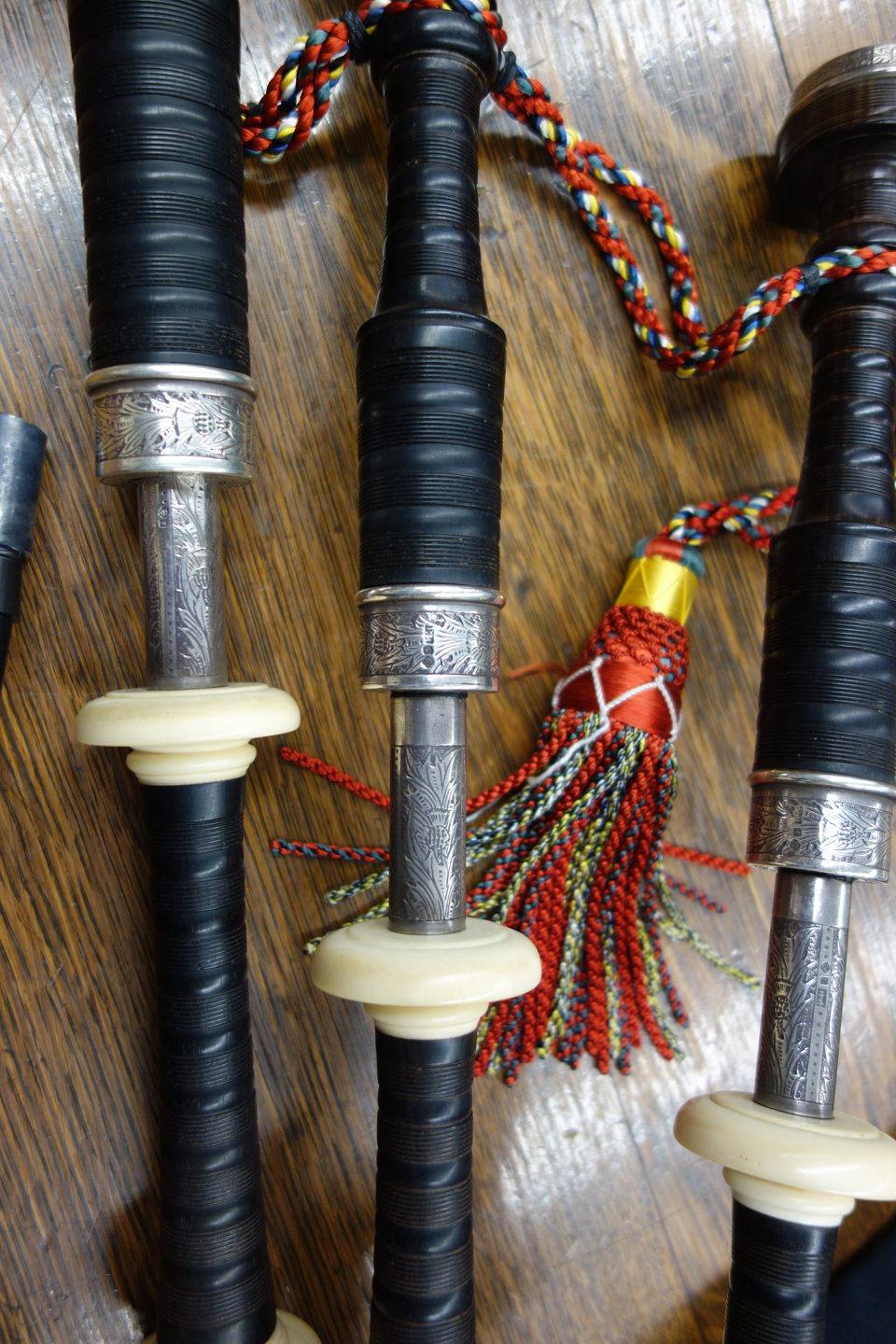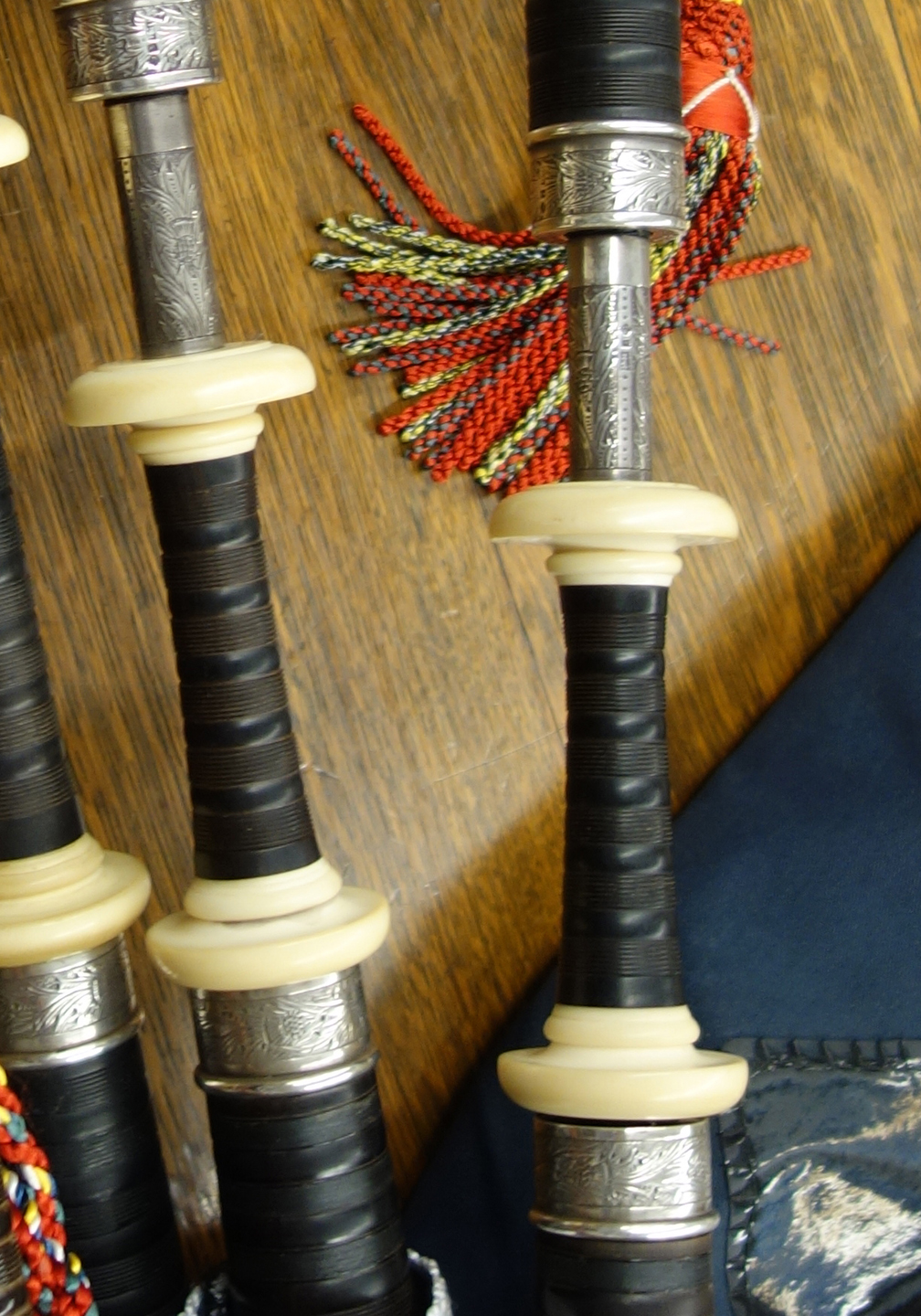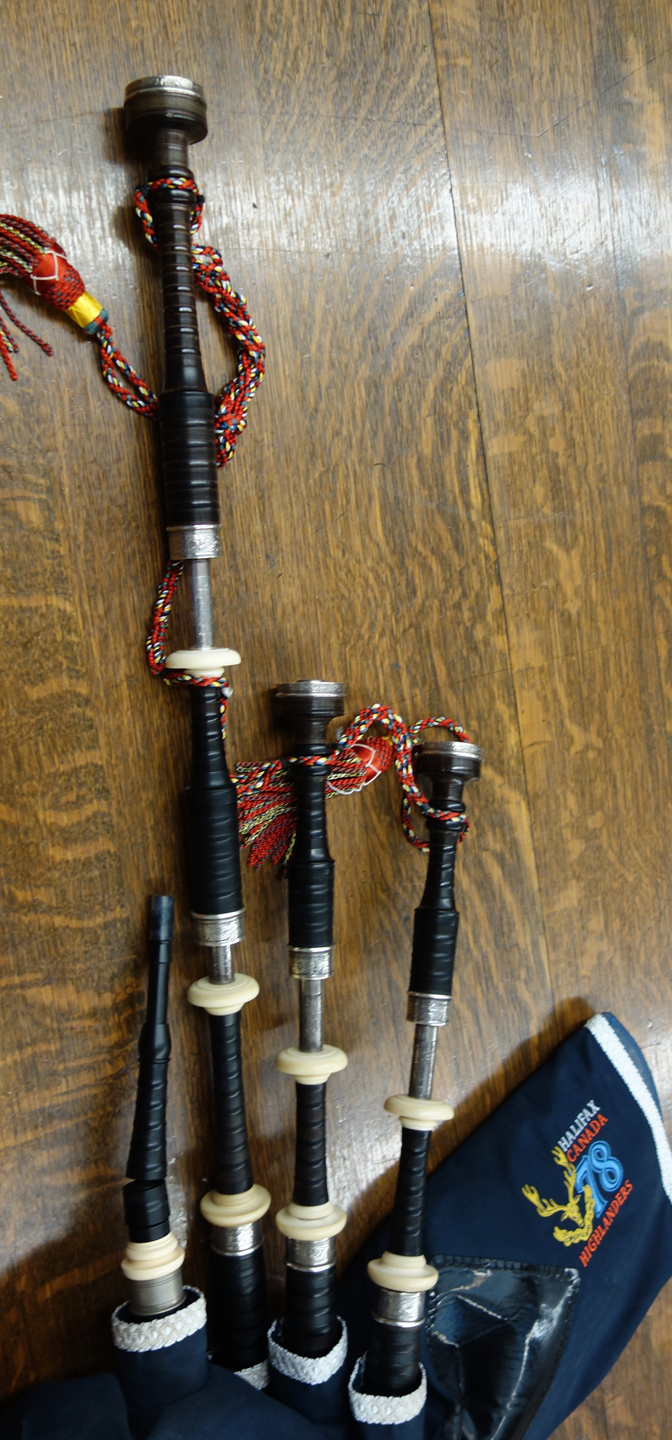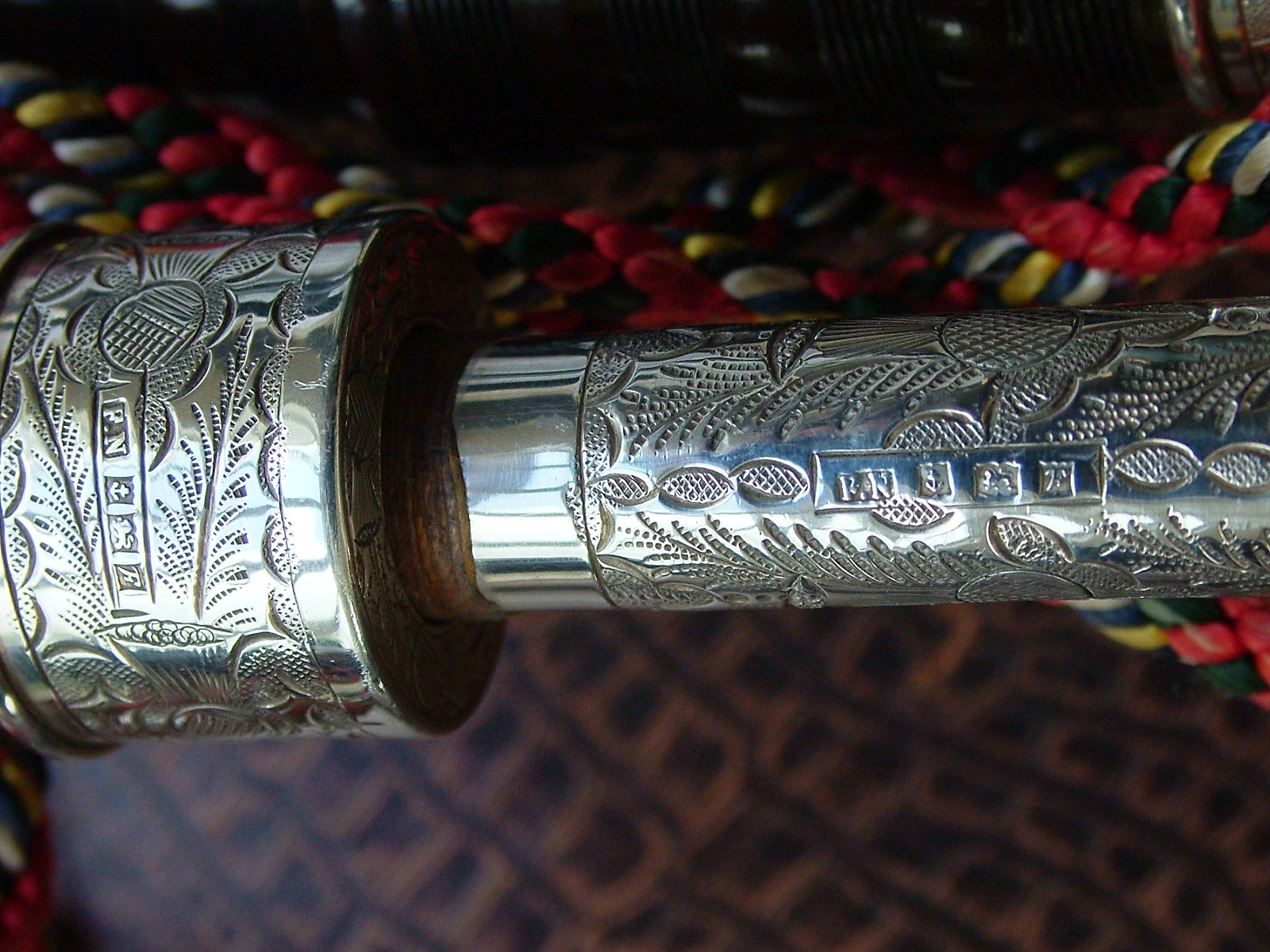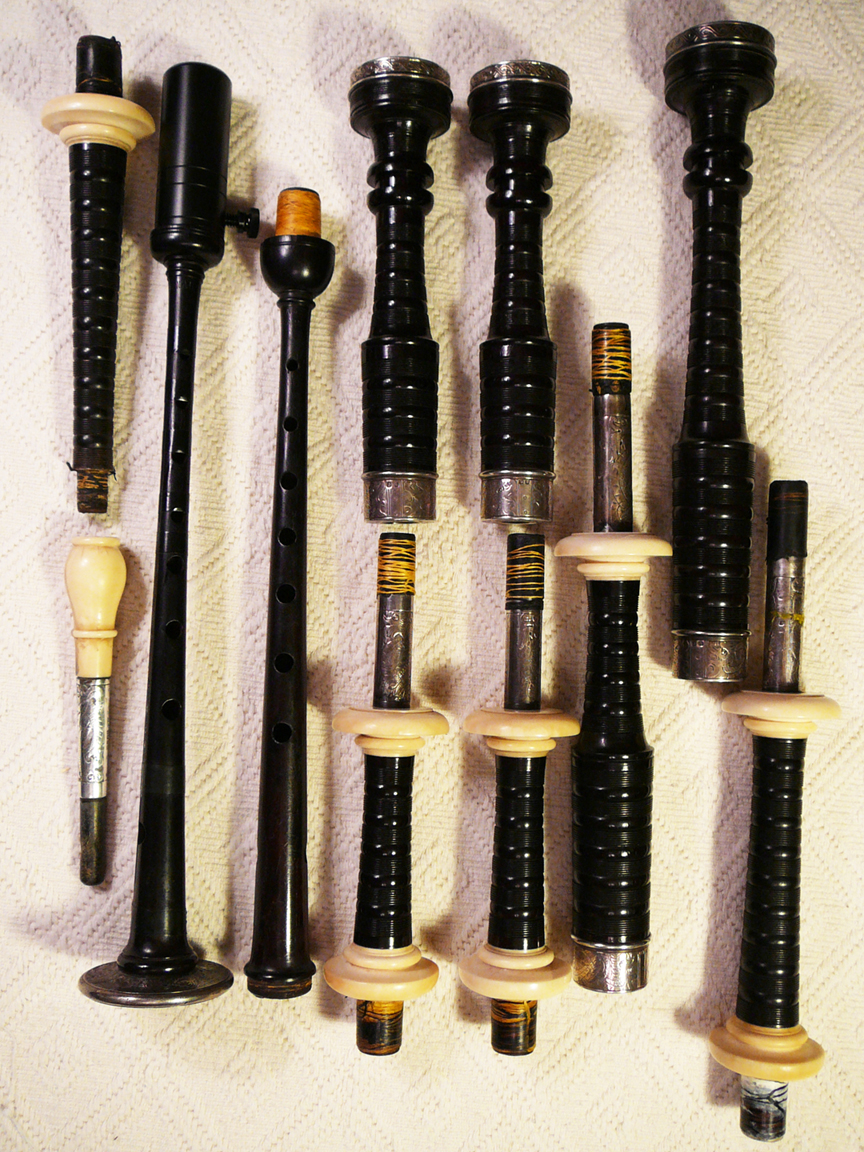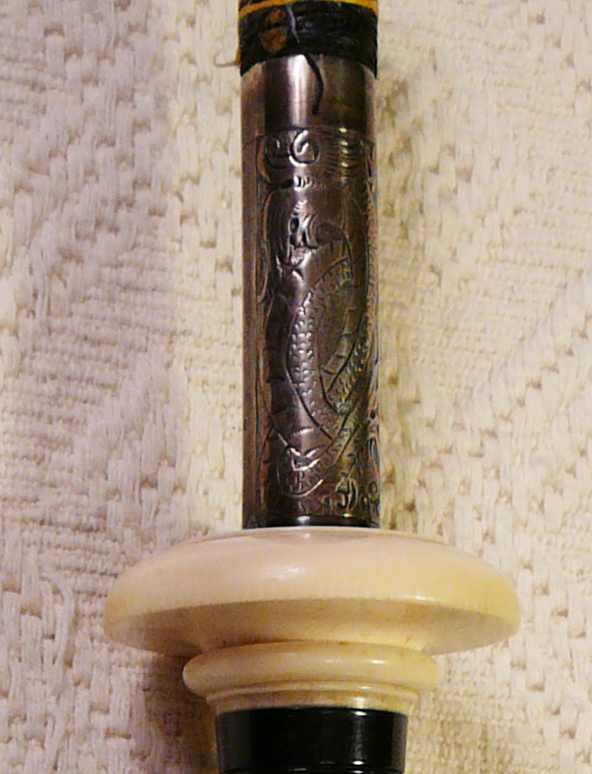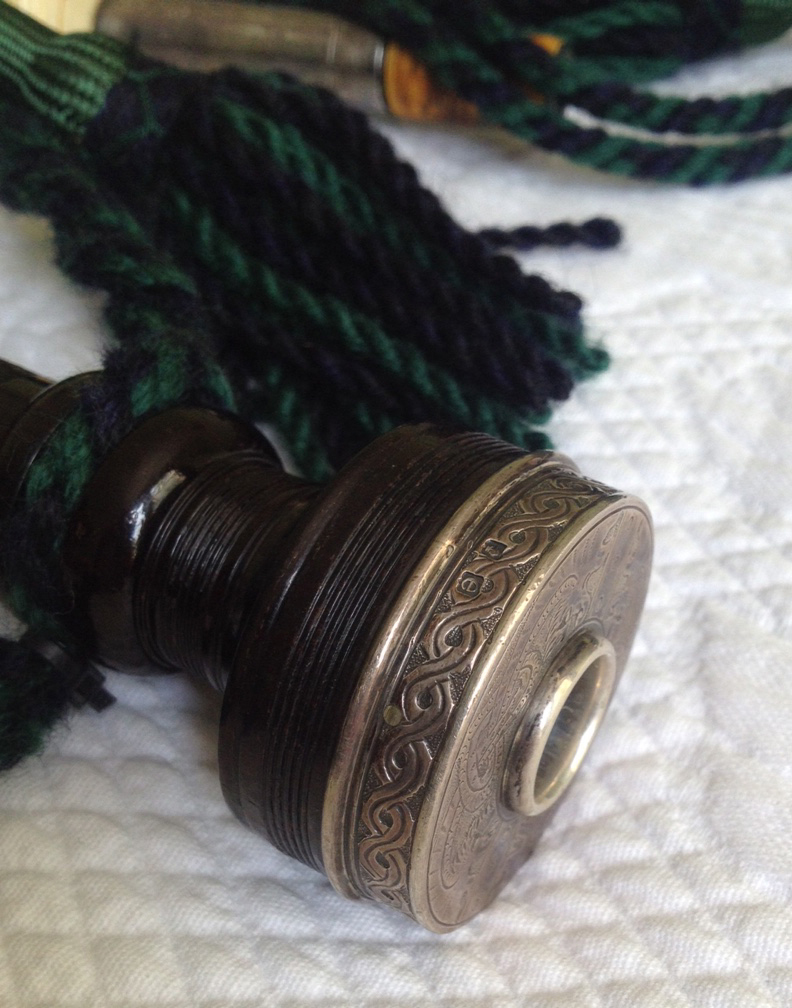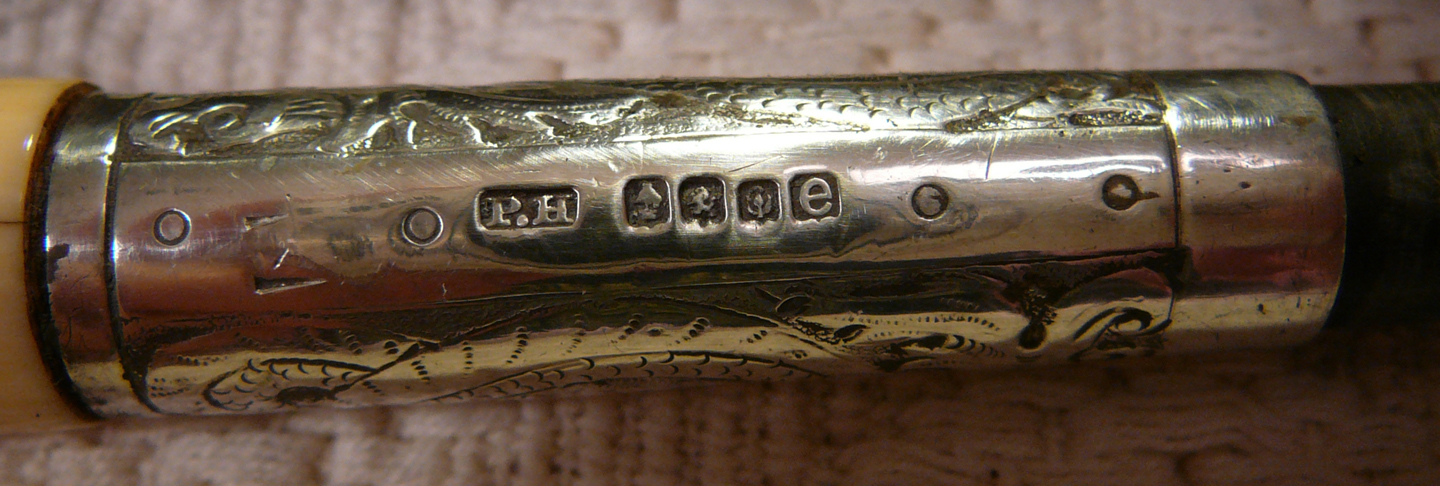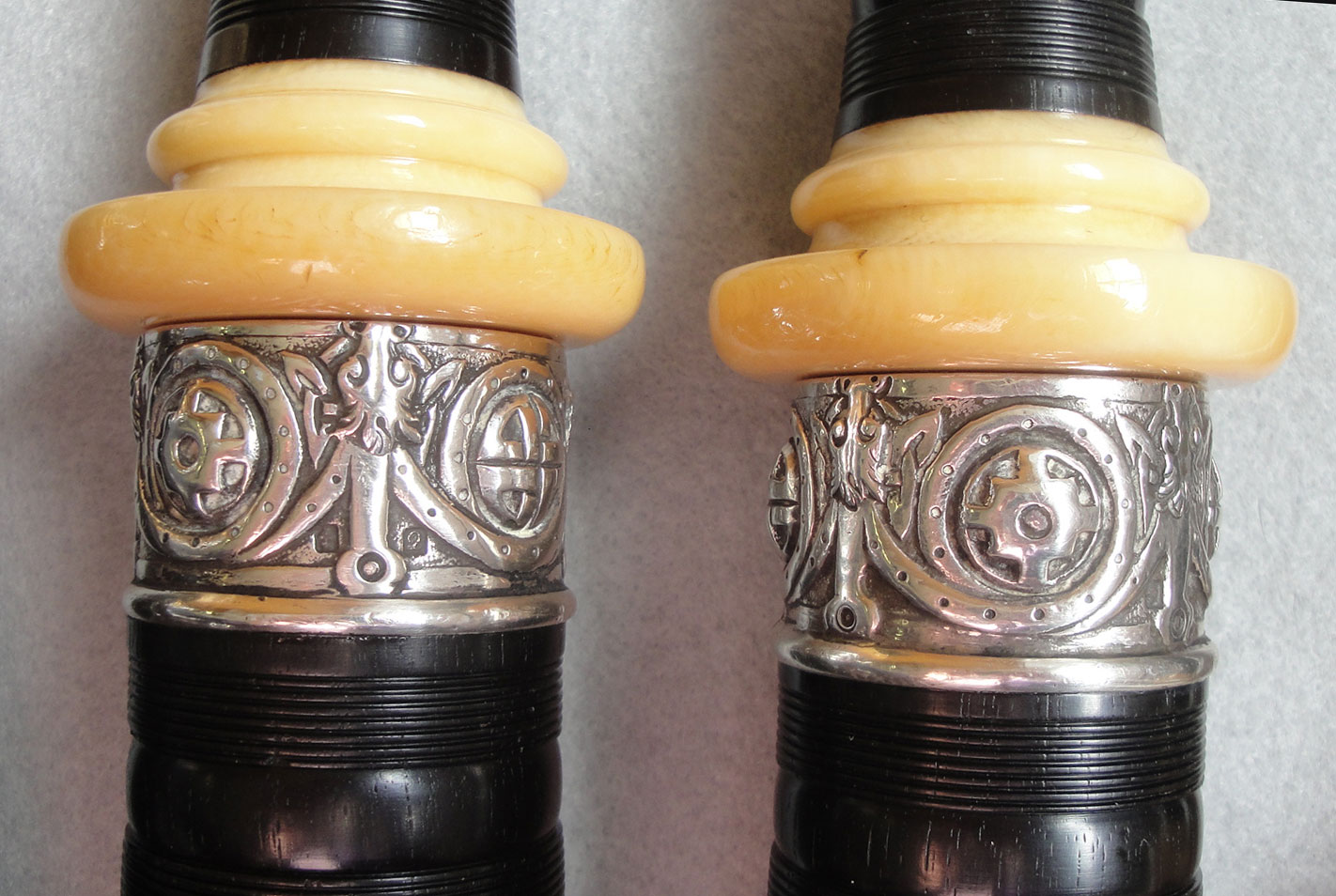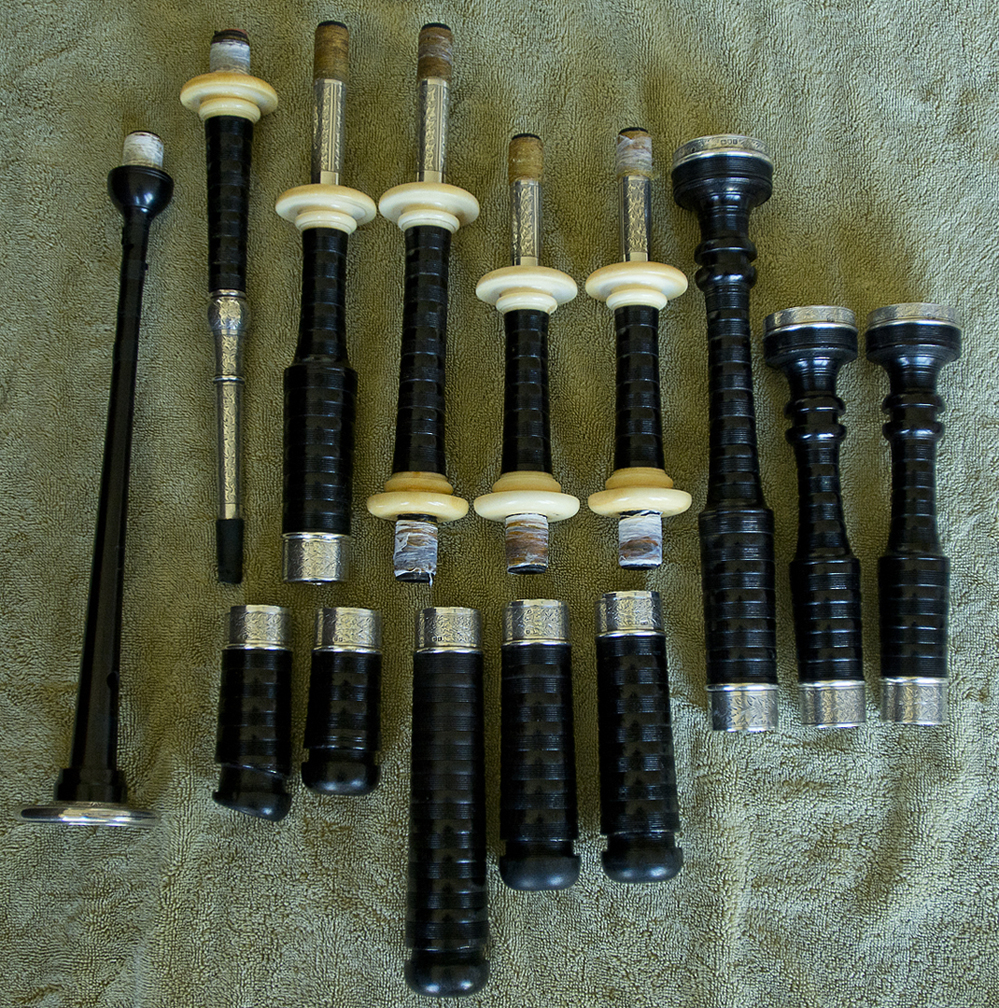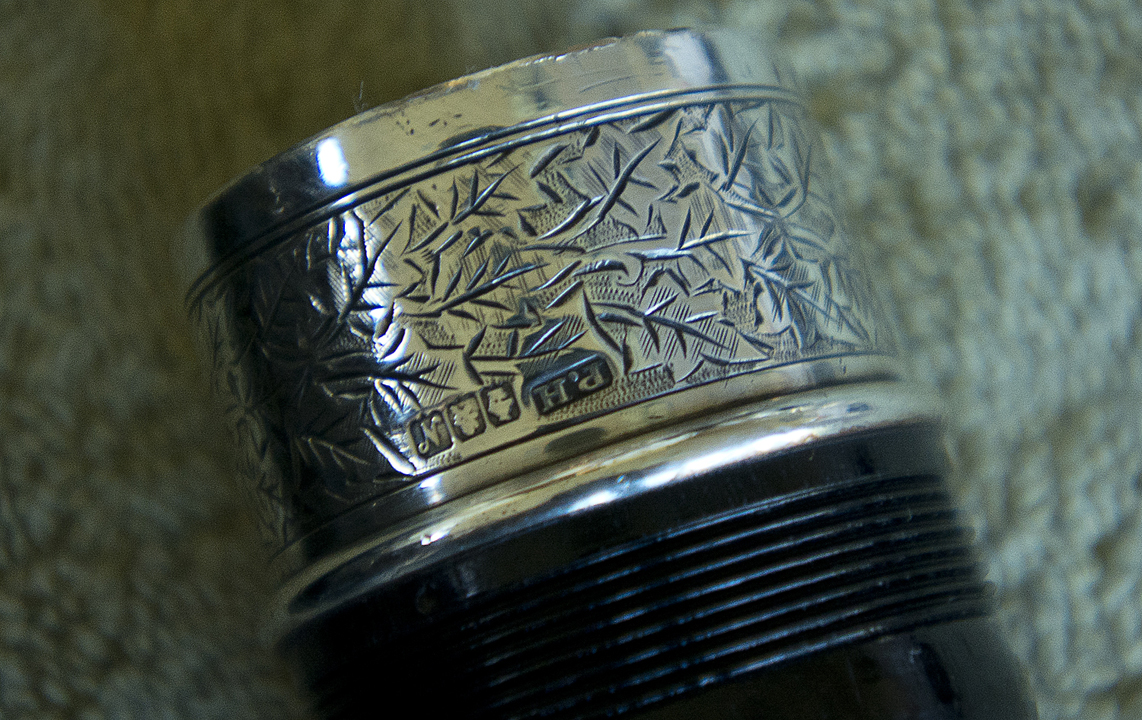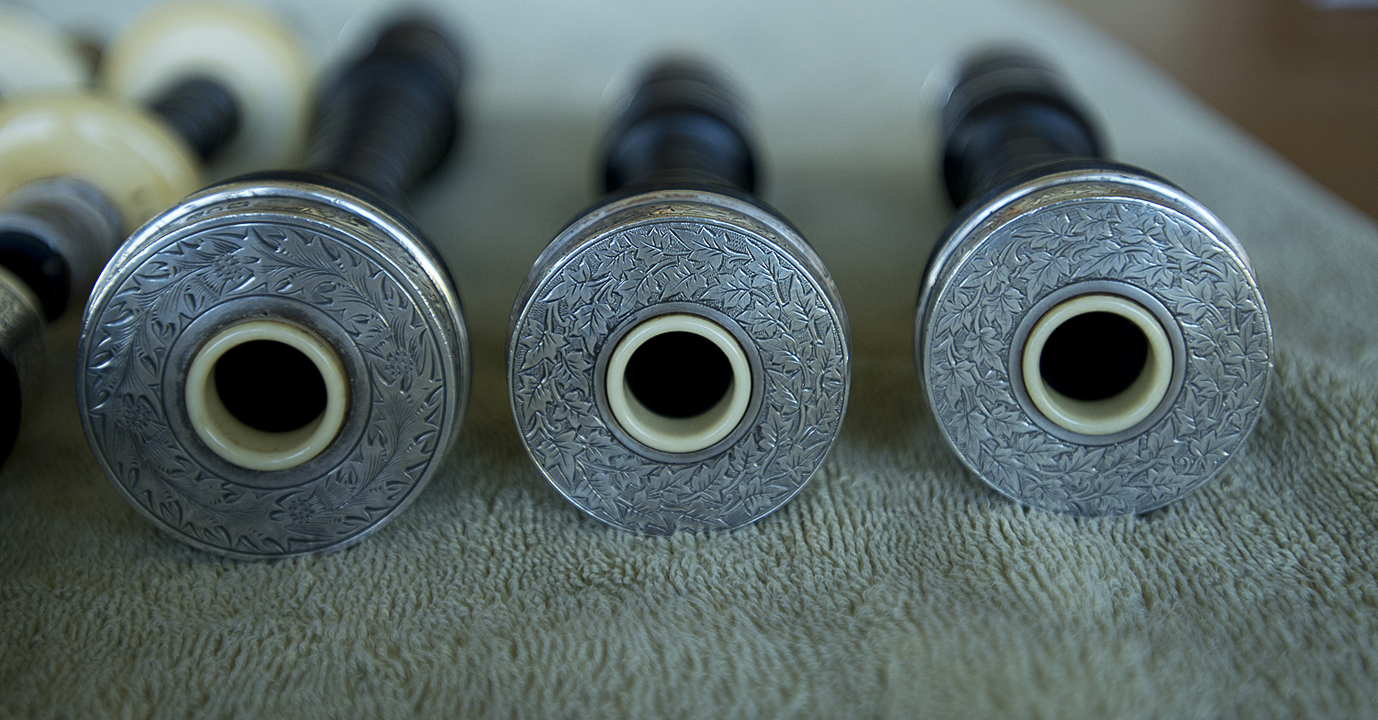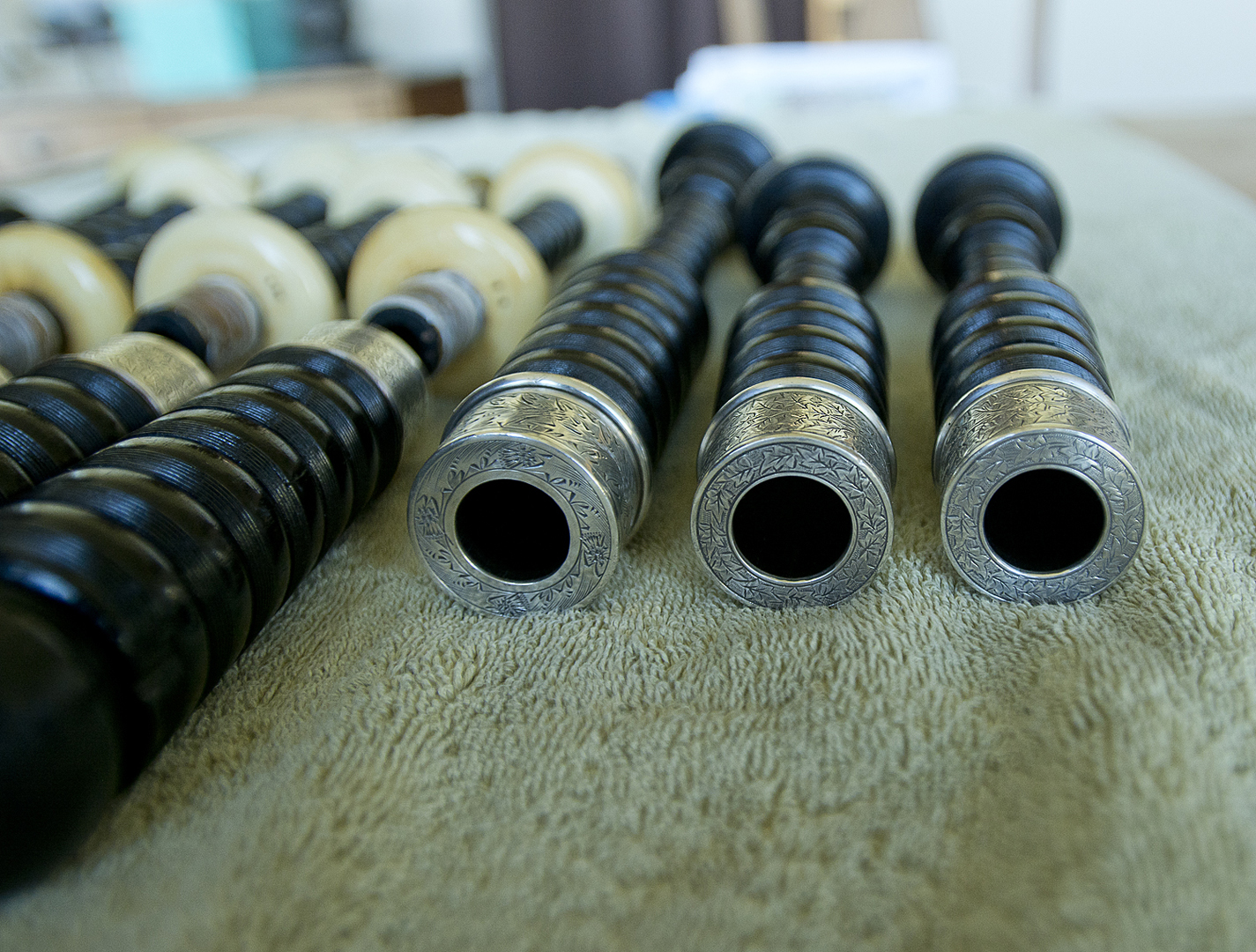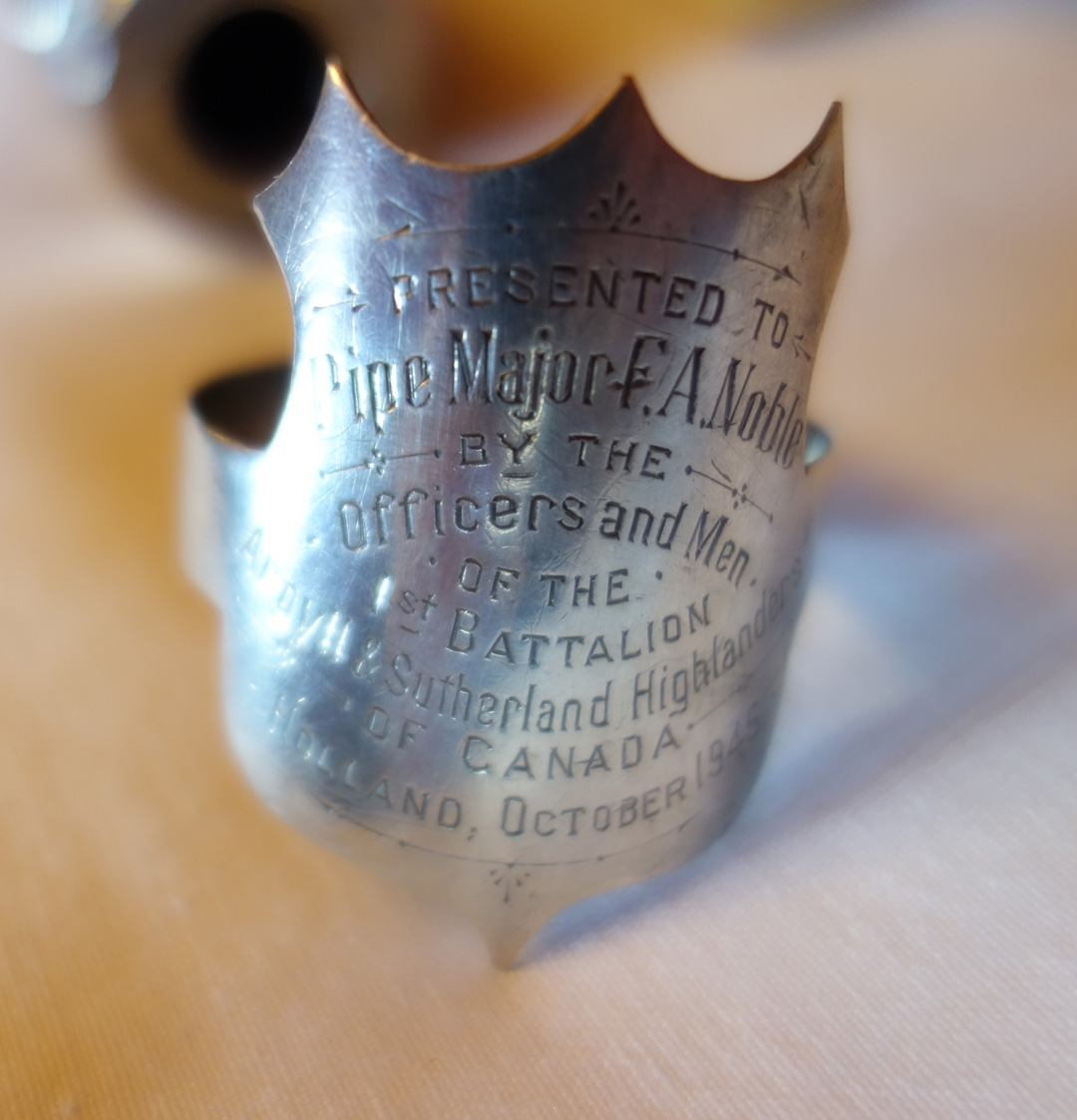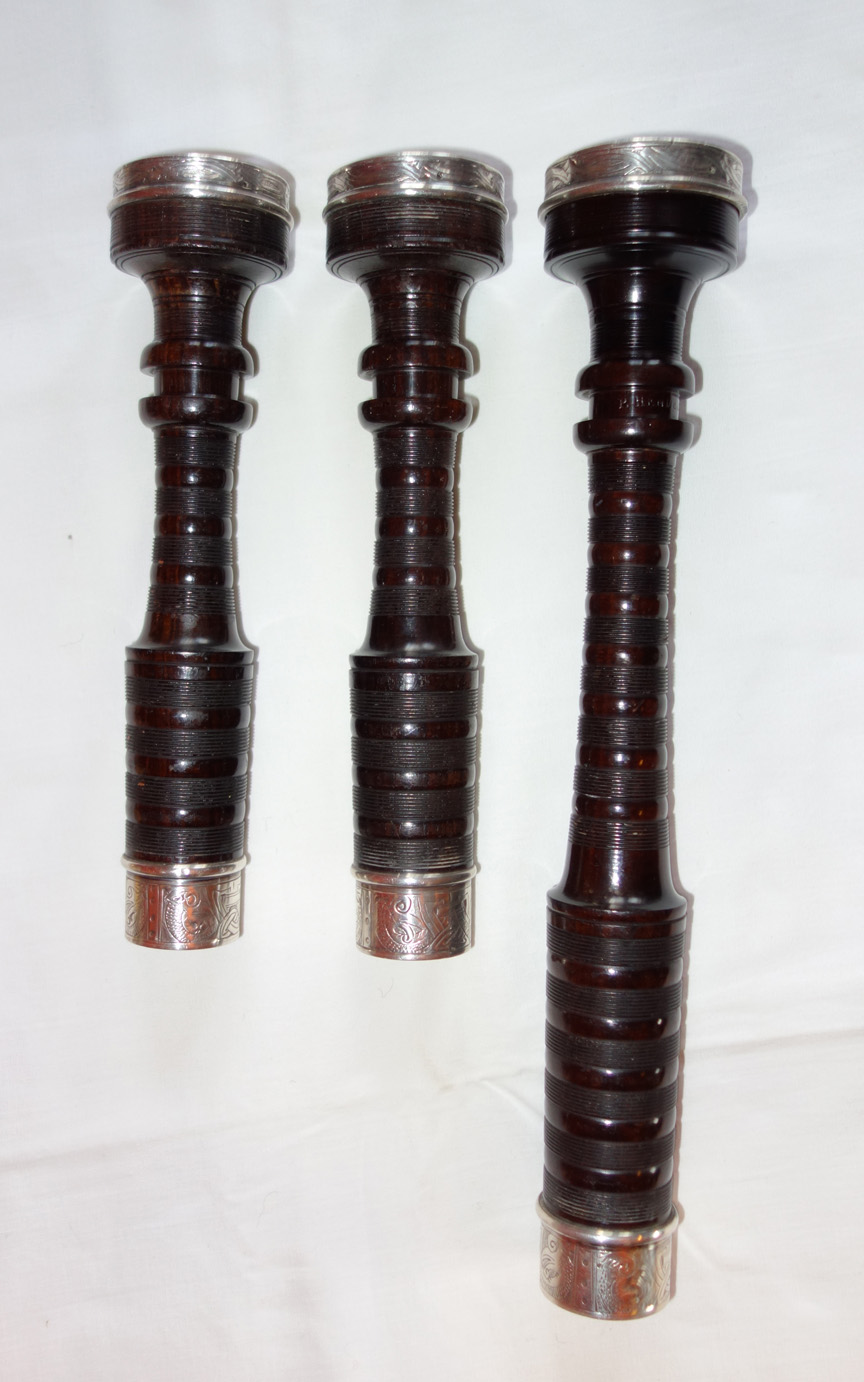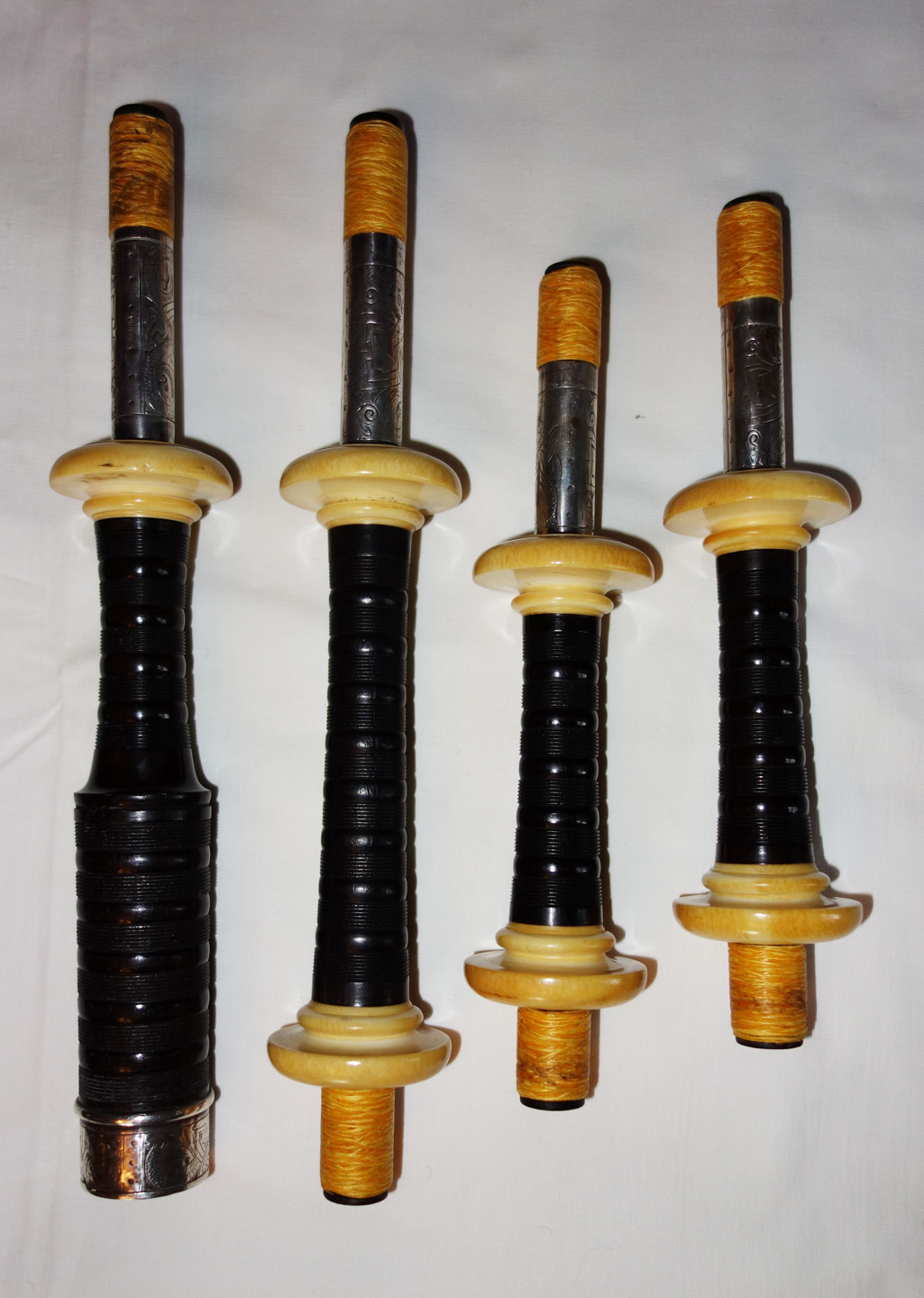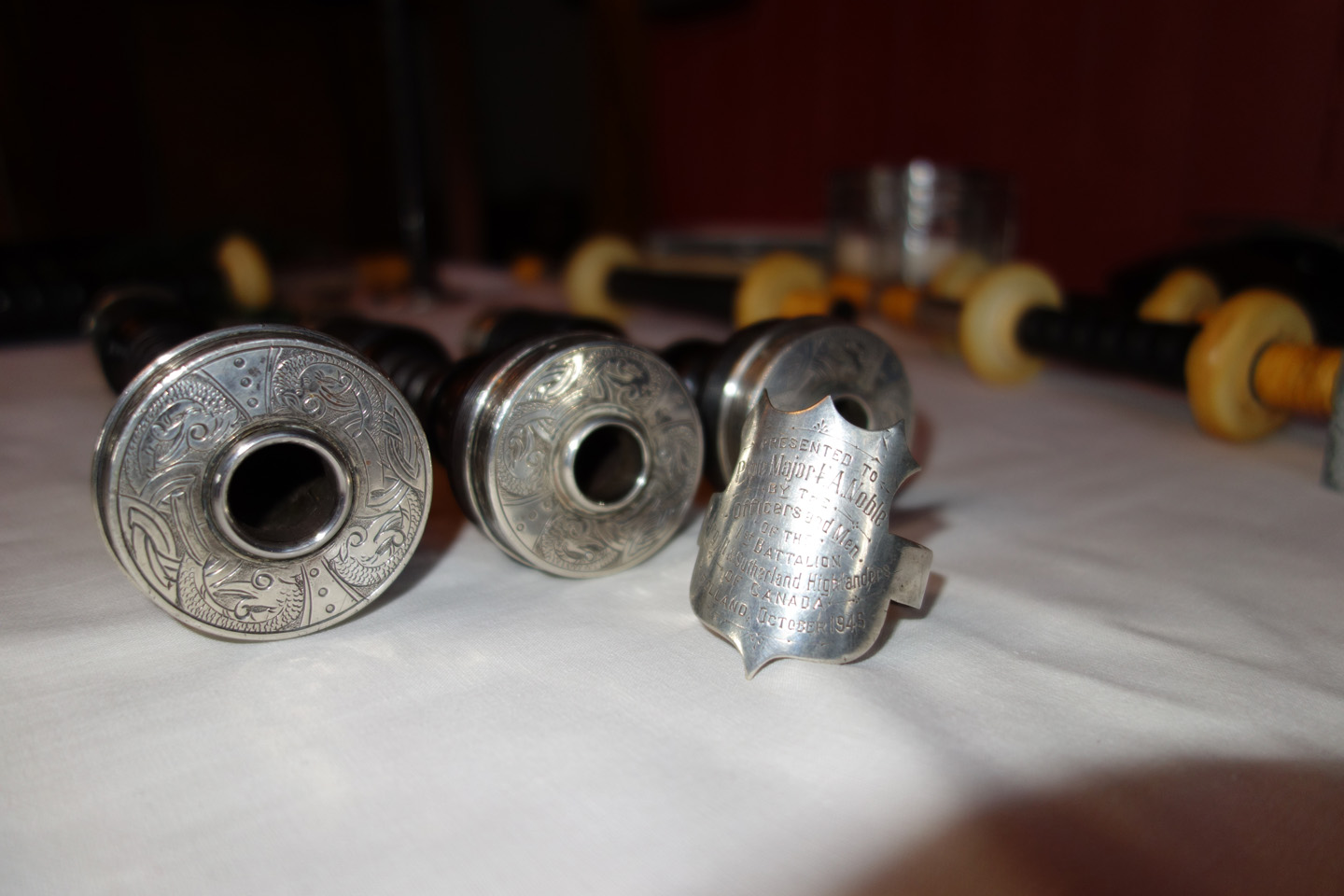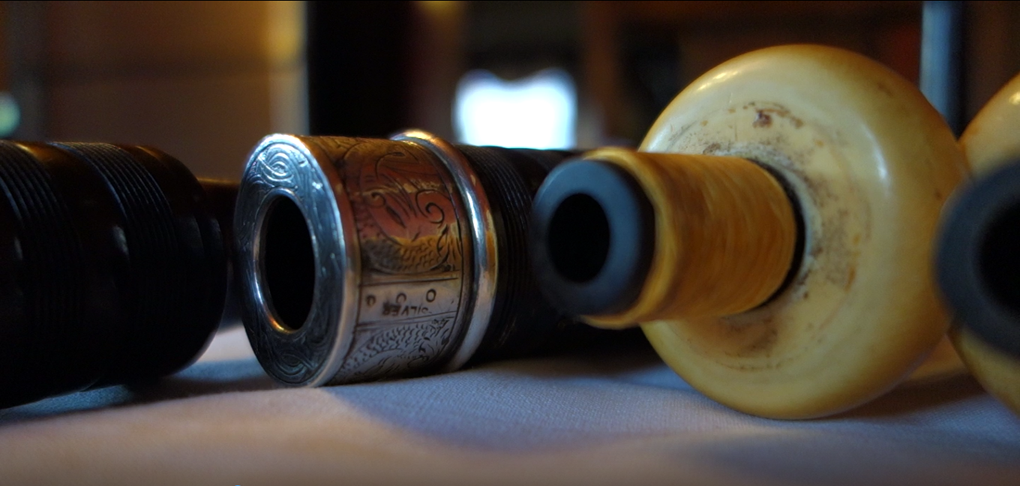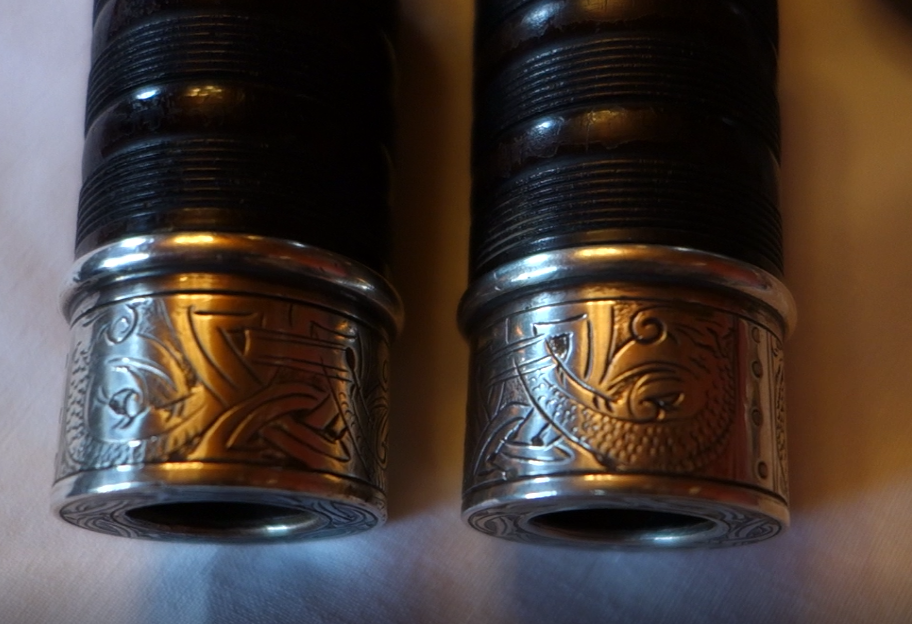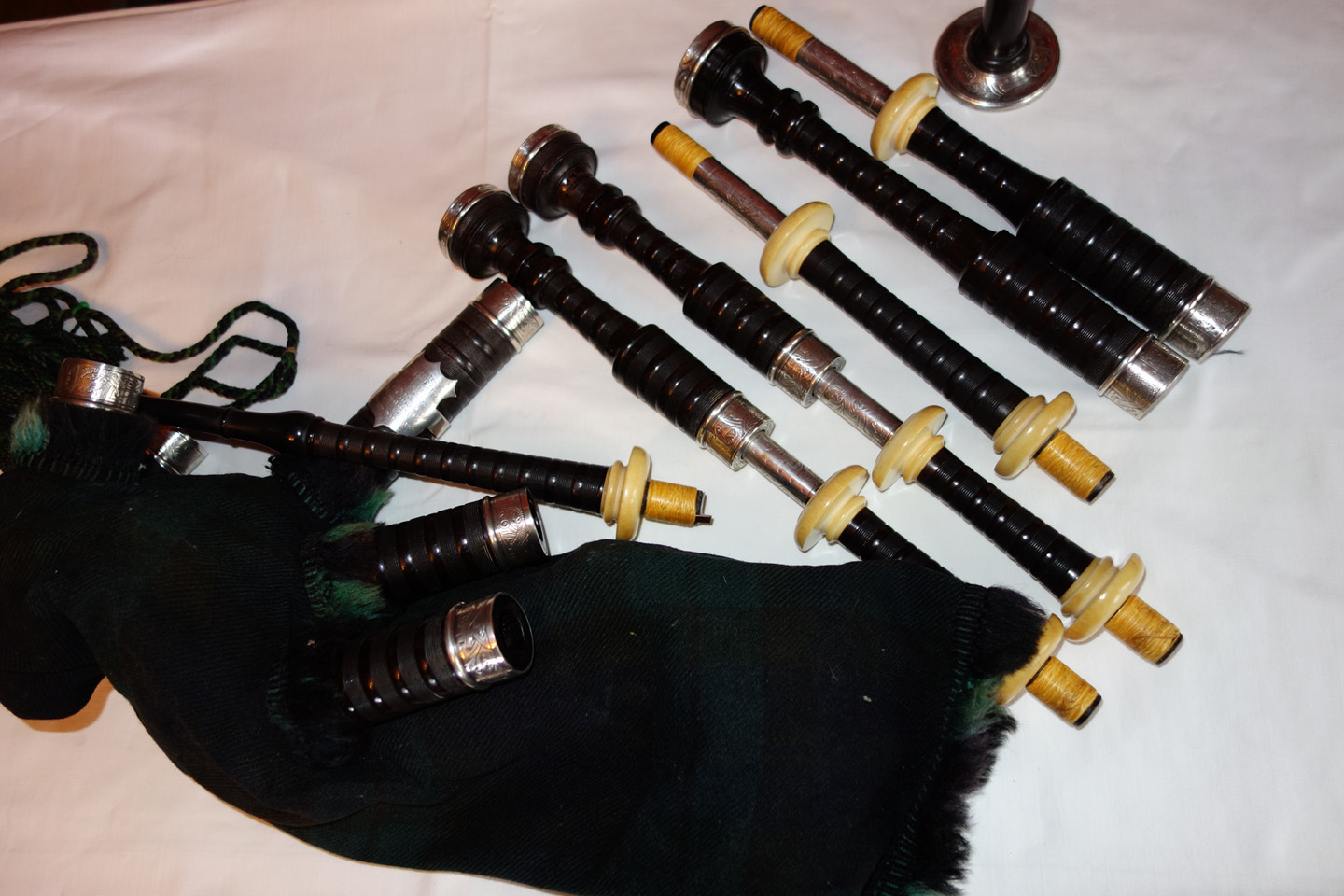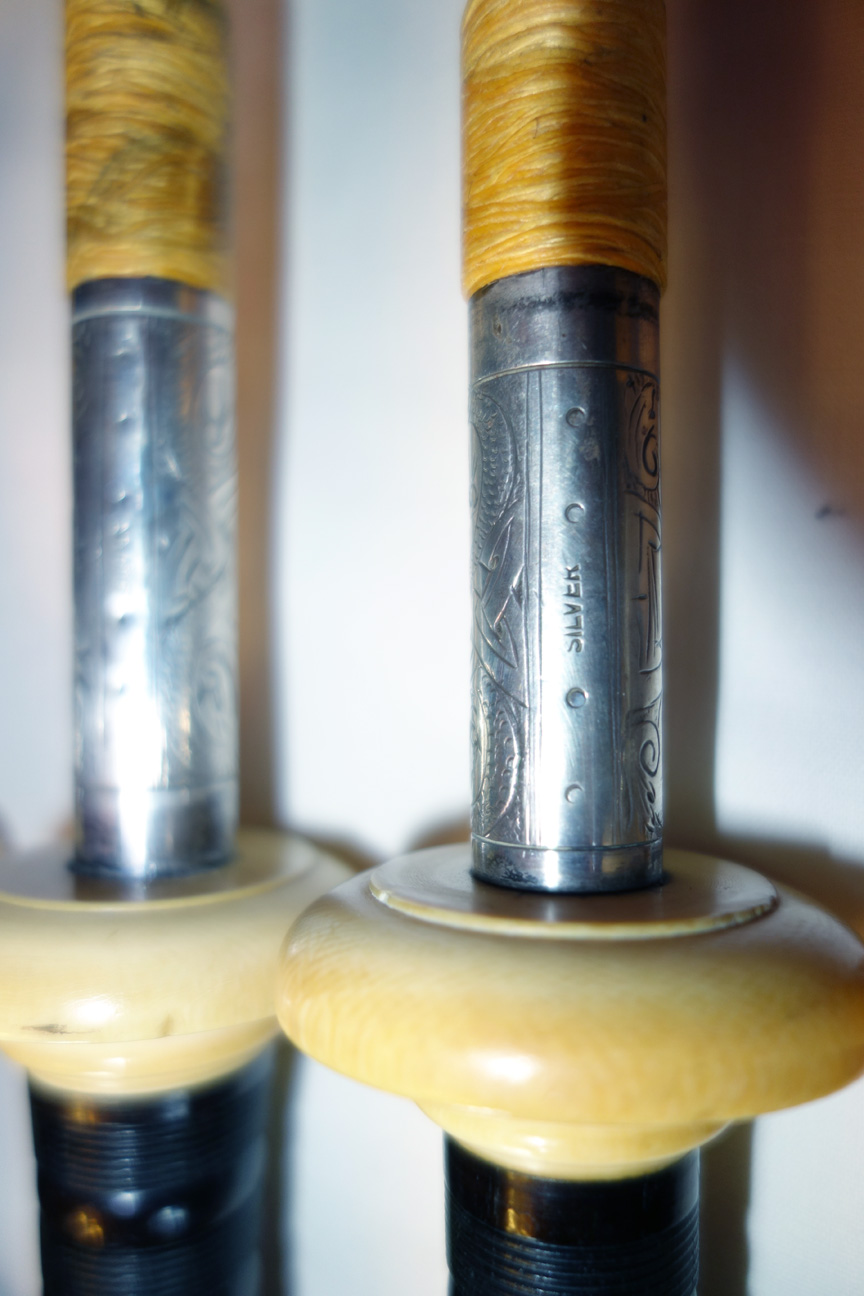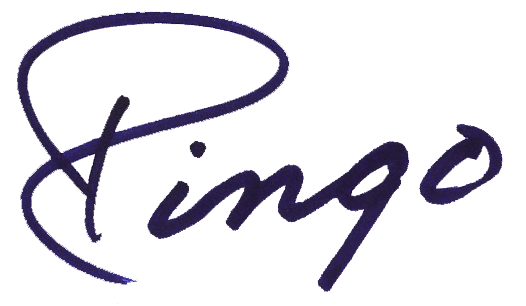The set immediately to the left and above is unique. It was a presentation set where the plaque is hallmarked 1915 and refers to a presentation date of 1916. The silver fittings are hallmarked 1914 and are cast. Actually they were cast in pieces and soldered together and then had additional detail "chased" throughout. Oh yeah, the design? I believe that the silver was a retro-fit. Why? No hemp stops. I'm pretty certain that this would not have been overlooked by the maker.
Henderson - Silver & Ivory
The "classic" Henderson bagpipe is silver and ivory and dates from the 1930's and earlier. The wood may be ebony, cocuswood, or African Blackwood. The silver was generally hand-chased by silversmiths employed by Henderson and it is generally superb. This page contains images of Silver and Ivory Henderson bagpipes from the very early days up to the last days to the Henderson business.
This bagpipe is believed to have been owned by Malcolm MacPherson and appears to be a Peter Henderson cocuswood bagpipe made around 1880 or so. It is currently the property of a descendant living in Ottawa, Ontario who received the bagpipe along with boxes of original manuscript music. I snapped this pictures at the Cambridge Highland Games in the early 1990's however failed to connect with the owner thereafter.
It is very unusual to find a Henderson bagpipe with cast silver. The Chanter sole above matches the silver on the Henderson bagpipe below.
I'm not a huge fan of putting new silver on old pipes however, if you like a classic bagpipe with bling, this ebony Henderson below is it!
The Henderson to the right and below is hallmarked 1910. Early Henderson silver was hand-chased, very detailed, and superbly crafted. Henderson employed their own silversmiths, who were kept very busy, no doubt.
The pipes in the photographs below are Peter Henderson 1916/17. They were played during WWI by Pipe Major James Groat originally from Durris Aberdeenshire, was decorated for at least three actions. These include Passchendaele and Vimy Ridge. His commanding Officer Colonel Cyrus Peck beside him during the last action was awarded the Victoria Cross. More can be learned of Groat through on-line searches.
Citation for the award of the Military Medal - For most conspicuous gallantry and nonchalance under shell and machine gun fire in the attack of April 9th, 1917 on the THELUS trenches. His splendid example while piping the Commanding Officer to the new headquarters in the captured position, encouraged and had an immediate stiffening effect on the men when temporarily held up by enemy machine gun fire.
Citation for the award of a Bar to Military Medal - On Aug: 15th 1917, this N.C.O. according to Battn custom played the Headquarters forward to their new position through a terrific shell-fire. He remained in the captured position until the Battalion was relieved two days later. His example has built up the “esprit du corps” of the pipers of the Regiment to such an extent that there is always a keen rivalry amongst them to lean their companies into action.
Citation for the award of the Distinguished Conduct Medal - For conspicuous gallantry and devotion to duty on the 2nd September, 1918, in the second battle Arras. For the fourth or fifth time during this war he played his Battalion over the top in a battle. He was continually under heavy machine gun fire and at one time was playing in the midst of furious hand-to-hand fighting. At last he was wounded by shrapnel after adding a fine record to the courage of Highland Pipers.
By the end of the war, PM Groat had won the DCM, MM, and Bar.
Citation for the award of the Military Medal - For most conspicuous gallantry and nonchalance under shell and machine gun fire in the attack of April 9th, 1917 on the THELUS trenches. His splendid example while piping the Commanding Officer to the new headquarters in the captured position, encouraged and had an immediate stiffening effect on the men when temporarily held up by enemy machine gun fire.
Citation for the award of a Bar to Military Medal - On Aug: 15th 1917, this N.C.O. according to Battn custom played the Headquarters forward to their new position through a terrific shell-fire. He remained in the captured position until the Battalion was relieved two days later. His example has built up the “esprit du corps” of the pipers of the Regiment to such an extent that there is always a keen rivalry amongst them to lean their companies into action.
Citation for the award of the Distinguished Conduct Medal - For conspicuous gallantry and devotion to duty on the 2nd September, 1918, in the second battle Arras. For the fourth or fifth time during this war he played his Battalion over the top in a battle. He was continually under heavy machine gun fire and at one time was playing in the midst of furious hand-to-hand fighting. At last he was wounded by shrapnel after adding a fine record to the courage of Highland Pipers.
By the end of the war, PM Groat had won the DCM, MM, and Bar.
It is very unusual to find a Henderson bagpipe with both engraved and plain silver fixtures. The absence of hemp-stops leads me to suspect that the silver on this set was added sometime after the bagpipe was originally made. The silver is hallmarked 1916.
Two 1950's Henderson bagpipe are shown below. The first is Bruce Gandy's dated 1953. Suffice to say that following WWII there were some excellent bagpipes still being produced by Henderson. The second set is hallmarked 1955. You can see that the projecting mounts have taken on a different look that very early Henderson bagpipe, however much is still the same.
The Henderson bagpipe below with silver dated 1927
The stocks perhaps weren't originally married to these drones. I'm thinking the stocks are much older.
Another instrument above dated 1916. The silver work is exquisite. It's hard to imagine the time and skill that went into a set like this.
It was a real treat to prepare a Certificate of Authenticity for this bagpipe. It's not often that you find a set in this condition with such a respected history. This set was presented to Pipe Major Frank Noble of the Argyll & Sutherland Highlanders, Canada in Holland in 1945. There are some outstanding words and pictures that can be seen here. There are several sites covering the contributions of the Argyll & Sutherland Highlanders over the years. Simply remarkable!
